 23/07/2010 14:37 23/07/2010 14:37 |
|
| | | OFFLINE | | Post: 20.653
Post: 3.291 | Registrato il: 28/08/2005
Registrato il: 20/01/2009 | Administratore | Utente Master | |
|


 See preceding page for earlier entries posted 7/23/10.
See preceding page for earlier entries posted 7/23/10.
 Friday, July 23, 16th Week in Ordinary Time
Friday, July 23, 16th Week in Ordinary Time
 ST. BIRGITTA (BRIDGET) OF SWEDEN (b Sweden 1303, d Rome 1373), Widow, Mystic, Franciscan Tertiary, Founder of the Bridgettines
ST. BIRGITTA (BRIDGET) OF SWEDEN (b Sweden 1303, d Rome 1373), Widow, Mystic, Franciscan Tertiary, Founder of the Bridgettines
Born to descendants of the Swedish royal family, Birgitta's father was one of the wealthiest landowners in the country. The girl started having visions of the Lord, particularly the Crucifixion, when she was 7. At age 13, she entered an arranged marriage to a local prince, with whom she had four sons and four daughters (the oldest, Catherine, would become a saint herself). She was a friend and counselor to many priests and theologians of her day, as well as adviser to King Magnus II. Her husband died in 1344 shortly after they came back from a pilgrimage to Santiago de Compostela. She joined the Franciscan lay order and lived as a penitent. In 1346, she founded the Order of the Most Holy Savior (Bridgettines) which was confirmed by Pope Urban V in 1370 and survives today with a few houses. In 1360, she left for Rome on pilgrimage and never returned to Sweden. She counseled Popes Clement Vi, Gregory XI and Urban VI, urging them all to return to Rome from Avignon. Meanwhile, she wrote down the revelations given to her in her continuing visions and her spiritual reflections; the books became hugely popular in the Middle Ages. She encouraged everyone to meditate on the Passion of Christ and on the Crucified Christ. She died in Rome after a pilgrimage to Holy Land which was marked by shipwreck and the death of a son. She was canonized in 1391, and in 1436, the Council of Basel confirmed the orthodoxy of her writings. In 1999, she was named by John Paul II as a co-patron of Europe, along with Benedict of Norcia, Cyril and Methodius, Catherine of Siena, and Teresa Benedicta (Edith Stein).
Readings for today's Mass:
www.usccb.org/nab/readings/072310.shtml
No papal stories in today's OR. Page 1 news is on the stress test to which 91 European banks will be subjected to test their viability; Obama signs an ambitious reform of the US financial system - and surprisingly, the brief article points out its major shortcomings and loopholes; Baghdad hit with a terror attack on a Shiite mosque, killing at least 30 and wounding 50 more. In the inside pages, at least five articles on German theologian Erik Peterson on the 50th anniversary year of his death; he worked in Rome from 1930-1960 since he converted to Catholicism and is best known for a massive work Ekklesia on the Catholic Church and its ecclesiology.
No announcements from the Vatican so far.
[Modificato da TERESA BENEDETTA 23/07/2010 16:53] |
| |
|
| |
 23/07/2010 15:10 23/07/2010 15:10 |
|
| | | OFFLINE | | Post: 20.654
Post: 3.292 | Registrato il: 28/08/2005
Registrato il: 20/01/2009 | Administratore | Utente Master | |
|
 The Vicariate of Rome today took the unusual step of issuing a prompt reaction to a sensation-mongering article in this week's issue of the Italian newsweekly magazine Panorama. The response appears in the diocesan online journal, Romasette.
The Vicariate of Rome today took the unusual step of issuing a prompt reaction to a sensation-mongering article in this week's issue of the Italian newsweekly magazine Panorama. The response appears in the diocesan online journal, Romasette.
Apparently, Panorama has been unable to find out any new stories of sexual abuse of minors by Roman priests, so it is striking out in another direction.
Note from the Vicariate
on the Panorama article
regarding gay priests
Translated from

July 23, 2010
The magazine Panorama, in its issue of July 23, out in newsstands today, has a long article entitled 'Le notti brave dei preti gay' (Happy night of gay priests), in which the writer claims to have spent some time with gay priests and recorded their activities with a hidden camera.
The purpose of the article is obvious: to create scandal, to defame all priests on the basis of a statement by one priest who claims that 98 percent of all the priests he knows are homosexual, and ultimately, to discredit the Church.
In the process, it purports to put pressure on the part of the Church that it calls 'intransigent, and persists in not looking at the reality' of homosexual priests.
The events narrated in the article can only bring pain and concern to the ecclesial community of Rome which knows its own priests - those who do not live a double life but 'one life only', which is happy and joyful, consistent with their vocation, dedicated to God and the service of their fellowmen, committed to live the Gospel and bear witness to it as a model of morality for everyone.
There are more than 1,300 of them in 336 parishes, and in oratories, multiple works of charity, various institutes of consecrated life and in other ecclesial organizations working in the universities, in the world of culture, in hospitals and on the frontiers of poverty and human degradation - not only in our city but in far lands and in difficult situations.
Those who really know the Church of Rome - where hundreds of priests from all parts of the world also live as students - know that the overwhelming majority do not in any way live a 'double life'. Few priests do not understand what it means to be a Catholic priest; and fewer still those who have decided that they should not have been priests at all.
They know that nothing forces them to remain priests. Consistency requires those who have had a change of heart to come forward. We wish them no ill, but at the same time, we cannot accept that their behavior results in smearing the honor of all other priests.
In the face of this, we adhere with conviction to what the Holy Father, Benedict XVI, Bishop of Rome, has repeated often in the past months: 'the sins of priests' call on all of us to a conversion of the heart and of our life, to be vigilant and not to "poison Christian faith and life, undermine the integrity of the Church, weaken its capacity for preaching and witness, and besmirch the beauty of her face".
The Vicariate of Rome is committed to pursue strictly, following the norms of the Church, all behavior that is unworthy of the priestly life.
The UK's Daily Express picked up the story, but surprisingly, without citing any specific details from the Panorqama account other than what the Vicariate note states::
Church of Rome
warns gay priests

July 23, 2010
ROME - The Italian Catholic church has told gay priests not to lead a "double life" after a magazine article showed priests frequenting homosexual clubs in Rome.
The Roman Catholic diocese of Rome said no one was forcing homosexual prelates to remain as priests. It said "we don't want to hurt them" but their conduct "muddies the reputation of all the others."
The weekly Panorma magazine said it interviewed several gay priests in Rome and accompanied them to clubs frequented by homosexuals in the capital. It quoted one as saying that 98% of the priests he knew were gay.
The Rome diocese said the article was aimed at defaming the Church.
Here's a surprisingly pro-Church reaction to the Panorama from one of Repubblica's Vaticanistas, who was never as one-sided as his former senior colleague, Marco Politi, who has retired, and whose replacement Marco Ansaldo has so far been far more objective than Politi ever was:
On self-indulgent gay priests:
The diocese of Rome has not
been remiss in policing itself
by ORAZIO LA ROCCA
Translated from

July 23, 2010
VATICAN CITY - The Vicariate of Rome's morality campaign among priests who carry out pastoral work in the Pope's diocese did not just begin today!
The new warning issued by Cardinal Vicar Agostino Valli following a 'shock' report by the weekly magazine Panorama is the latest in a long series of such warnings and steps inspired by Benedict XVI - first when he was Prefect of the Congregation for the Doctrine of the Faith and famously denounced the 'filth' within the Church in his 2005 Good Friday meditations and prayers on the Stations of the Cross.
And then, as Supreme Pontiff and Bishop of Rome, in pubic and private meetings, and during his general audiences, Benedict XVI has always stressed the need to renew ecclesial life starting with the moral and spiritual comportment of priests and religious - but also of bishops and cardinals.
This is a theme he has repeated in dozens of interventions - homilies, catecheses, public addresses - and in 'inconvenient' reminders in recent months, in the documents he has issued with regard to the revival of public scandal over pedophile priests, but also with the far from limpid behavior of ecclesiastics and monsignors involved in miscellaneous events that have nothing to do with pastoral work.
The German Pope has not been remiss in 'moralizing' interventions that do not leave anyone indifferent - neither the advocates of a necessary self-cleansing of the Church, nor those who think that the Pope's admonitions have been unnecessarily broad in inculpating the entire Catholic community. [He has not! except insofar as everyone is a sinner, Catholic or not, but he has always made it clear that the pedophile priests represent a few individuals in the entire worldwide population of 400,000 priests!]
Not to forget that there are not a few, within the Church and outside it - who think that the Pope and the Vatican have always moved behind the curve.
Polemic aside, Papa Ratzinger, as everyone knows, published last week the updated norms under which the Congregation for the Doctrine of the Faith has been dealing since 2003 with serious offenses against the faith, against morals and against the sacraments, offenses over which it has jurisdiction.
In the diocese of Rome itself, in addition to the general norms cited, the past year has also seen a kind of routine screening of the lives of priests working in the capital - 1,935 foreign-born and 1,325 Italians (total 3,260).
Th operation is called 'Recognition' and was designed principally to verify each priest's compliance with canonical norms set in 1935, initially for foreign priests working in Rome, with particular attention to their rights and duties but especially to their moral conduct.
Vicariate sources said that a number of foreign-born priests have been dismissed from diocesan work or laicized after being found culpable of immoral acts. Some of them, even if no longer priests, continue to say Mass and solicit contributions for alleged charitable work.
The Panorama 'investigation' focuses on three priests, said to be employed in the Roman Curia - who celebrate Mass in church or in private in the daytime, but who carry on sexual relations with fixed or casual partners at night. [So the 'investigation' only concerned three priests? Sorry, I have no interest in checking out the article itself, so I did not know. The Vicariate note should have made that clear - it seemed as if the investigation was far broader. Three out of 3,260 are three swallows made to look like the entire bird population of Rome, and obviously quite a stretch!
Also, if the three priests investigated are employed in the Roman Curia, are they considered priests of the diocese when presumably, they have no pastoral assignments?]
Thus, the new exhortation from the Vicariate asking homosexual priests "to come out into the open and, for consistency, to leave the priesthood". A firm and unequivocal appeal with a reminder that diocesan authorities will not tolerate the 'lifestyle' described in Panorama.
Of course, in the diocese - beyond the disappointment and concern about Panorama's tratment of the story - prelates, including those among Papa Ratzinger's, know that the road towards eliminating the 'filth' from the Church is long, difficult and full of obstacles.
NB: For some reason, the major Anglophone news agencies are only now reporting the news of the priest in Youngstown, Ohio, who has been laicized by the Vatican following sexual abuses committed in thr 1970s. An Ohio TV station reported this on 7/19, and I posted the story same day on the preceding page of this thread.
[Modificato da TERESA BENEDETTA 24/07/2010 00:43] |
| |
 23/07/2010 15:38 23/07/2010 15:38 |
|
| | | OFFLINE | | Post: 20.655
Post: 3.293 | Registrato il: 28/08/2005
Registrato il: 20/01/2009 | Administratore | Utente Master | |
|

 UK government moves to 'protect'
UK government moves to 'protect'
the Pope from arrest during visit

July 22, 2010
SkyNews is a UK-based international news service, best known for its 24/7 TV news operations.
The Government has moved to prevent the possibility of an arrest warrant being issued against the Pope during his state visit this autumn.
Sky News understands that Whitehall officials have been "seriously concerned" that campaigners would use international criminal rules to try to detain the Pontiff while he is in the UK.
Richard Dawkins, Christopher Hitchens and human rights lawyer Geoffrey Robertson QC were among those campaigners reported to be looking at the options for bringing a private prosecution in relation to the Pope's alleged cover-up of sexual abuse in the Catholic Church.
Now Justice Secretary Ken Clarke has proposed changes to the rules on universal jurisdiction, a law that allows individuals to be prosecuted in the UK for serious offences such as war crimes, crimes against humanity and torture even if they were carried out abroad.
The plans would mean the Director of Public Prosecutions would need to give his consent to any arrest warrant issued under universal jurisdiction.
This would effectively mean taking that power out of the hands of the courts.
Ministers say the current rules are open to abuse because the evidence required to get a warrant is far below the threshold that would be needed to bring a prosecution. This has meant the rules are often used by those who wish to make a political statement or to cause embarrassment.
The most recent attempt to obtain an arrest warrant for a foreign dignitary was ahead of the visit by former Israeli defence minister Tzipi Livni who cancelled her trip at the last minute to avoid embarrassment.
"Our commitment to our international obligations and to ensuring that there is no impunity for those accused of crimes of universal jurisdiction is unwavering," Mr Clarke said.
"It is important, however, that universal jurisdiction cases should be proceeded with in this country only on the basis of solid evidence that is likely to lead to a successful prosecution - otherwise there is a risk of damaging our ability to help in conflict resolution or to pursue a coherent foreign policy.
"The Government has concluded, after careful consideration, that it would be appropriate to require the consent of the Director of Public Prosecutions before an arrest warrant can be issued to a private prosecutor in respect of an offence of universal jurisdiction."
The state visit this September will be the first visit by a Pope to the UK since 1982.
70,000 pilgrims expected
for Papal Mass to
beatify Cardinal Newman

July 23, 2010
Because this is a report from the Press Association (the UK version of Associated Press, to which most major UK media subscribe), the story appears in most of the UK media today.
Up to 70,000 people from the UK and around the world are expected to attend a special Mass in Birmingham where Pope Benedict XVI will beatify Cardinal John Henry Newman, it has been announced.
Cardinals, bishops and more than 1,000 priests will be present at the Mass in Cofton Park on September 19, at the end of the Pope's four-day visit to Britain.
The beatification will be the first to be carried out personally by Benedict since he was elected Pope in 2005, a mark of his lifelong interest in and study of the 19th century clergyman and famous convert from the Church of England to Catholicism.
[Shortly after his election, Benedict XVI changed the practice followed by his predecessor, and decreed that the formal beatification rite be performed in the home diocese of the new Blessed rather than at the Vatican, to which the Pope sends a representative for the rites, usually the Prefect or Emeritus Prefect of the Congregation for the Causes of Sainthood. The visit to the UK was in part planned around the beatification of Cardinal Newman, enabling the Pope himself to preside at the beatification rite.]
The ceremony will bring the revered clergyman, who died in 1890, a step closer to becoming the first non-martyred English saint since before the Reformation.
Pilgrims at the Mass will be asked to make a £25 contribution, the Catholic Church said, to cover the costs of travel, use of the park and a "pilgrim pack" for the occasion.
A spokesman for the Catholic Church in England and Wales said the £25 cost could be paid by parishes, fundraising efforts or through donations by benefactors.
"This is about a pilgrim's journey. The idea is that they are representatives of their parishes," he said. "We want to encourage the idea of a pilgrimage and going collectively. We want to move away from the view that you are buying a ticket and this ticket gives you access to a concert."
Peter Jennings, press secretary to the Archbishop of Birmingham, the Most Rev Bernard Longley, said: "It is a momentous occasion for this Pontificate, for the Pope to actually beatify anybody, and it is a tremendous honour for the Catholic Church in England and Wales."
The Pope is expected to make a private visit to the Oratory House in Edgbaston, Birmingham, opened by Cardinal Newman in 1852, where he spent most of his life as a Catholic and where he died in 1890. He is due to visit Cardinal Newman's room and his private chapel before becoming the first pilgrim to pray at a new shrine to the Blessed John Henry Newman.
The Pope will then travel to the Roman Catholic seminary of St Mary's College, Oscott, Sutton Coldfield, for a private visit where he will address the Catholic bishops of England, Scotland and Wales in the chapel where Newman was confirmed a Catholic in 1845.
It seems the demand for tickets to a papal Mass has not been reported so much in previous trips by Benedict XVI:
Glasgow to get 25,000 Pope tickets
by Jasper Hamill

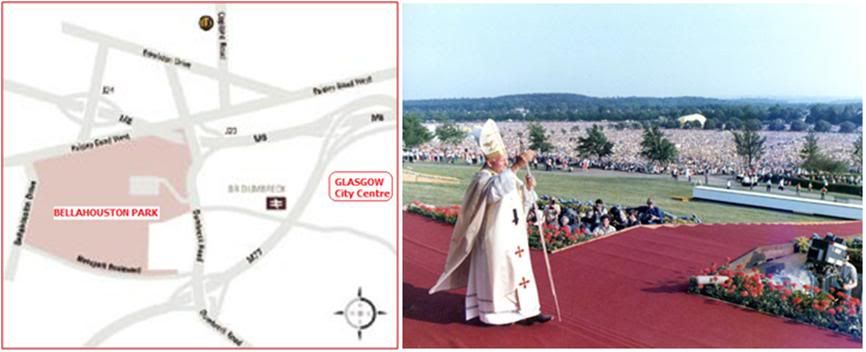 Bellahouston Park in relation to Glasgow city centre; right, some 300,000 crowded into the Park in 1982 for John Paul II's Mass. Tree growth since then considerably limits available space for Massgoers today.
Bellahouston Park in relation to Glasgow city centre; right, some 300,000 crowded into the Park in 1982 for John Paul II's Mass. Tree growth since then considerably limits available space for Massgoers today.
Worshippers in Greater Glasgow are expected to be offered the largest share of tickets to see Pope Benedict XVI in Bellahouston Park.
One in four of the almost 100,000 tickets will be offered to people living in and around the city, with the other 75,000 split between parishes around Scotland.
The Catholic Church will start sending letters out to parishes over the weekend, telling them how many tickets each of them has been allocated for the Mass, which takes place on September 16.
Each parish will be given a set number of tickets, based upon their number of regular worshippers.
Parishes in Greater Glasgow will be offered 25,000, the largest share of the tickets.
Second is Lanarkshire (24,000) followed by Edinburgh, Fife, Lothians
and Borders (17,000); Renfrewshire and Inverclyde (11,000); Ayrshire, Dumfries and Galloway (5,000); Aberdeenshire, Highlands and Northern Isles (4000); Dundee, Angus and Tayside (4000) and finally Argyll, the Western Isles and Lochaber (2000).
Catholics are so keen to see the Pope that 5000 tickets will be also be handed out to parishes in the north of England, as the Bellahouston Park Mass offers them the best chance of seeing the Pontiff. A batch of 2500 will also be sent to Northern Ireland.
The Catholic Church has not offered explicit advice on how parishes should decide how to distribute their allotted tickets.
Demand is so high that in some areas ballots are expected to be held.
[Modificato da TERESA BENEDETTA 24/07/2010 11:10] |
| |
 23/07/2010 16:25 23/07/2010 16:25 |
|
| | | OFFLINE | | Post: 20.656
Post: 3.294 | Registrato il: 28/08/2005
Registrato il: 20/01/2009 | Administratore | Utente Master | |
|



July 22, 2010
You asked me questions with great frankness and at the same time showed that you have firm points, convictions. And this is very important. You are young men and women who think, who question themselves, and who have a sense of truth and good. In other words, you know how to use your minds and your hearts, and that is no small thing."
- Pope Benedict XVI, To Young People in the Cathedral in Sulmona, July 4, 2010
I.
The lovely town of Sulmona, in L'Aquila, in Italy, is famous for being the birthplace of the Roman poet Ovid, for its goldsmiths, and for "confetti," sugar coated almonds passed out at weddings and other festive occasions.
It is also famous for being the home of the one Pope who actually resigned his office, Pope Celestine V, a hermit who ruled the Church for about six months.
Not surprisingly, when Benedict visited Sulmona recently, I saw articles speculating whether he might be thinking of resigning since he had an interest in this obscure pope. That this pope might have once looked forward to retiring in Bavaria goes without saying. But once pope, he understands that his office is for life.
The town's patron is St. Pamphilius, after whom the Cathedral is named. This is where, on his recent visit, the Holy Father gave a brief talk to young men and women gathered in the Cathedral.
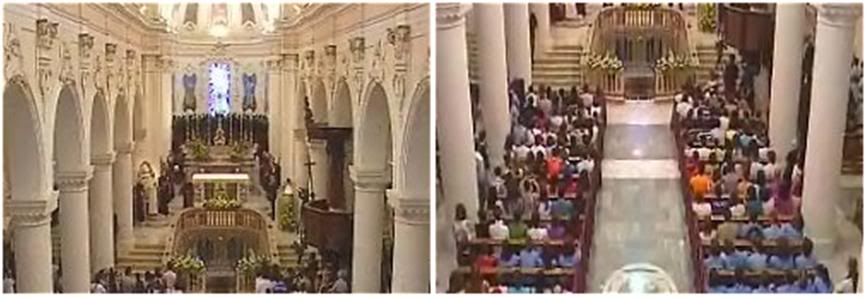

He did not talk to them about changing the world's social structures. He did not talk of philosophy or theology even, but he did talk about history and using their heads. The students evidently had asked him some questions to which he responded.
Both John Paul II and Benedict are at their best in youth audiences. Imagine anyone else in the world telling young men and women that it is "no small thing" to use their minds!
Benedict adds:"I would say that it is the main thing in this world: to use the intelligence and wisdom that God has given to you properly."
This again is a theme that is typical of Catholicism at its best. It recognizes that our minds are not our own original creations. We are given them by God in the very being we have received, a being that does not originate with us.
We are to use our minds and hearts at the same time. We are not to be afraid of intelligence or insight. But we know that we can choose to use them improperly. These usages the pope calls "shadows," perhaps after Plato.
The only thing that can really challenge the improper use of mind is to use it properly, to seek and find the truth of things.
Benedict remarks on the faith and moral values found among the people of that region. But there are "false values" and "deceptive models". They too promise to fill human life, but they are "empty." Benedict knows the relativism and skepticism that surround all of today's youth, even those in Sulmona.
II.
The pope commends the students for recalling to him the example of Pope Celestine, as well as remembering some of the Pope's own words in Sydney.
"The memory of the past is truly an 'extra gear' in life, because without memory there is no future. It was once said that history is a teacher of life!" The past concretizes things for us.
"The contemporary consumer society tends instead to relegate human beings to the present, to make them lose their sense of the past, of history; but by doing so it deprives them of the ability to understand themselves, to perceive problems and to build the future."
The notion of being "relegated" to the present, to be free of history, and hence alone and by oneself, is a powerful one. The Christian is "someone who has a good memory, who loves history and seeks to know it."
The students asked: "How does one recognize God's call?" The Pope, following the example of the hermit Celestine, speaks of inner and exterior silence.
"St. Peter Celestine was first and foremost this: a man of listening, of inner silence, a man of prayer, a man of God."
We must in fact take steps to be outside the culture, to allow within our souls other voices than the immediate ones that constantly pound us from media and ideology.
"Being with God, listening to his word, in the Gospel and in the Church's Liturgy, protects you from the dazzle of pride and presumption, from fashion and conformism, and gives you the strength to be truly free, even from certain temptations masked as good things."
III.
The students also asked the delicate question of "How we can be in the world but not of it?"
Praying in our room, meditating, going to Mass, Benedict says, does not "remove" us from the world. It rather "helps us be ourselves". not subject to pervasive forces.
"Dear friends, faith and prayer do not solve problems but rather enable us to face them with fresh enlightenment and strength, in a way that is worthy of the human being and also more serenely and effectively."
As he often does, Benedict recalls the examples of actual saints in history. They began first with prayer and attention to God. The Pope even talks of a kind of spiritual "entrepreneurship" helped by the Spirit. Not everything that the world most needs is already contained in the world with its own standards.
The Pope says that one of the"badges" of being a Christian is that he is never merely an "individualist". Are not hermits and monks such "individualists"?
"The monk does not live for himself but for others and it is for the good of the Church and of society that he cultivates the contemplative life so that the Church and society may always be irrigated by new energies, by the Lord's action."
There always needs to be amidst the affairs of the world, for the good of the world, those whose life is primarily directed to God.
The Pope urges the students to love the Church, the bishops and priests, "in spite of all our weaknesses." Following the Lord is a joy, the Pope remarks, after recalling the rich young man in the Gospels who went away "sad" because he had many riches.
What is the sign of being a Christian? "For you Jesus Christ is worth so much - even though it is demanding to follow him - that he is worth more than anything else."
Benedict tells the youth of Sulmona to read the Confessions of Augustine, surely a soul-changing book if there ever was one.
Finally, Benedict says, "I must now depart and I must say that I am sorry to leave you! With you I feel that the Church is young! But I am happy as I leave, like a father who is serene because he has seen that his children are growing up and growing up well."
One cannot, in conclusion, help wonder with all the attacks on fatherhood and the family. how many young people actually understand this sentiment of the Pope. He is the Holy Father; he sees in all such gatherings, the hope for eternal life in which we were created.
|
| |
 23/07/2010 18:19 23/07/2010 18:19 |
|
| | | OFFLINE | | Post: 20.657
Post: 3.295 | Registrato il: 28/08/2005
Registrato il: 20/01/2009 | Administratore | Utente Master | |
|
 LOOKING IN ON THE POPE
LOOKING IN ON THE POPE
AT CASTEL GANDOLFO
The Vatican today released a brief video showing the Holy Father in Castel Gandolfo.
www.youtube.com/watch?v=7nig8Tz21pU&feature=player_embedded
Here are some videocaps:
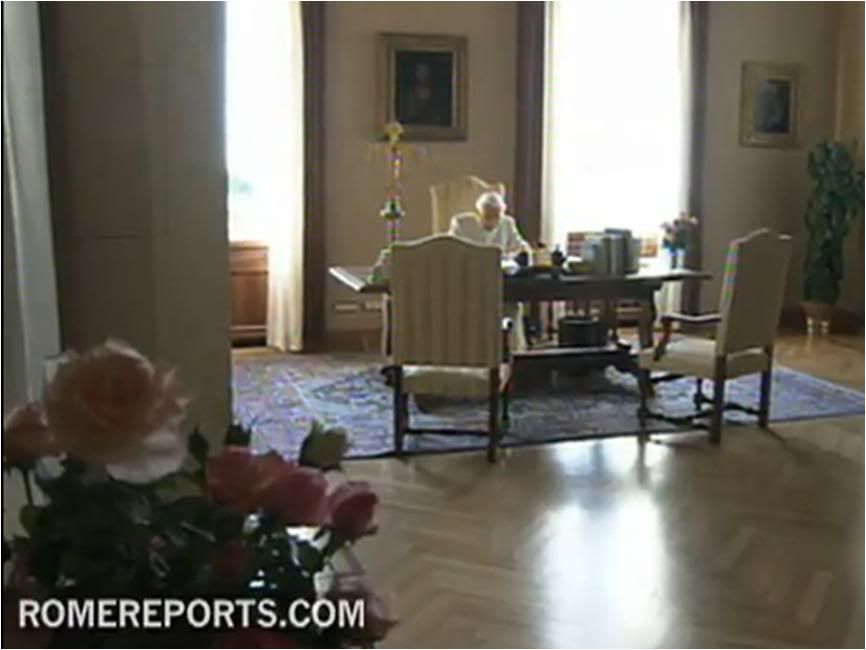
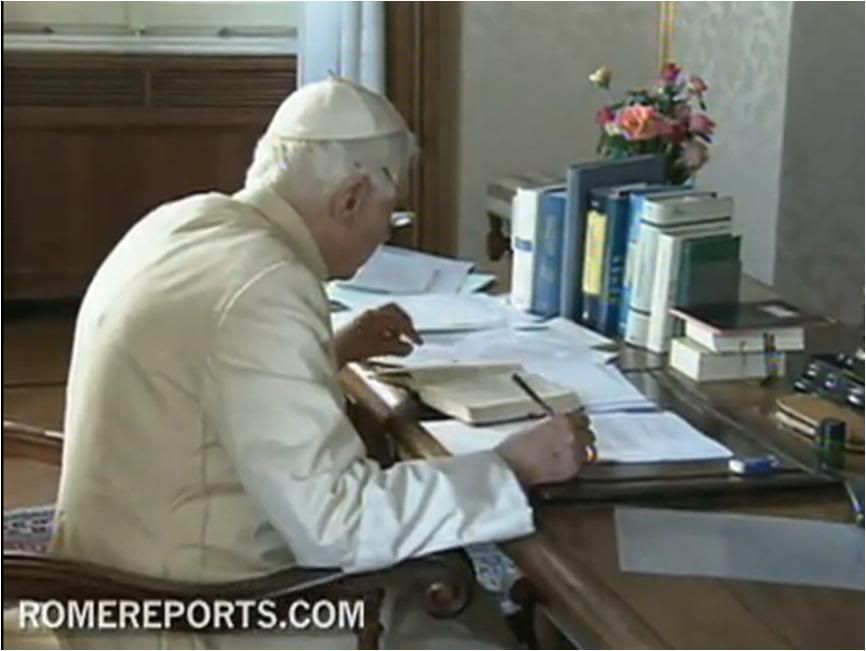
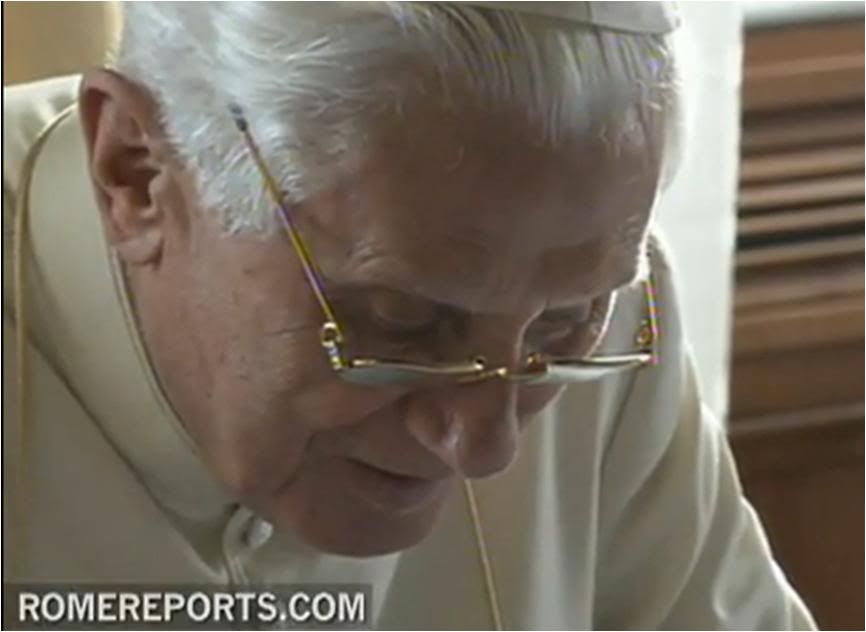
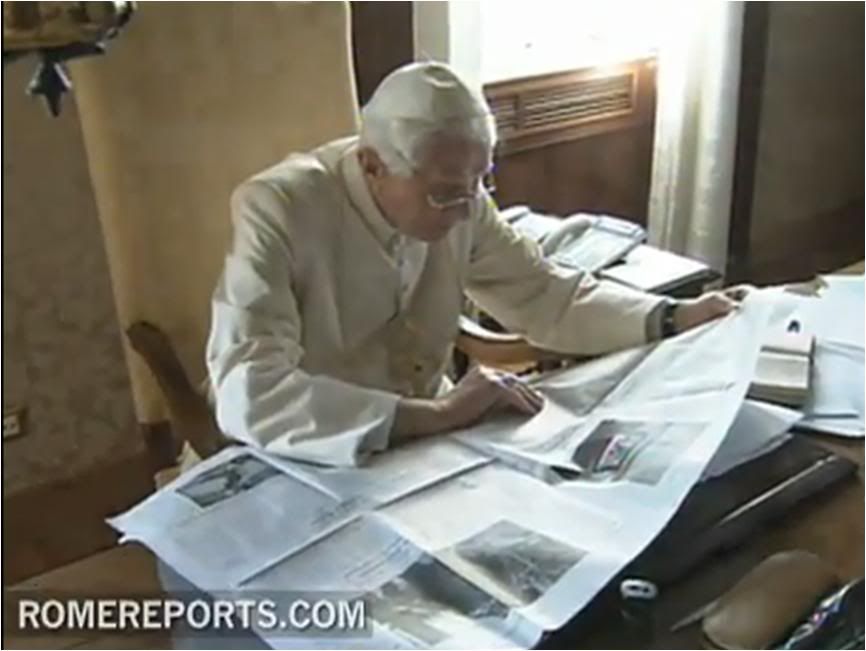 The baseball cap is back:
The baseball cap is back:

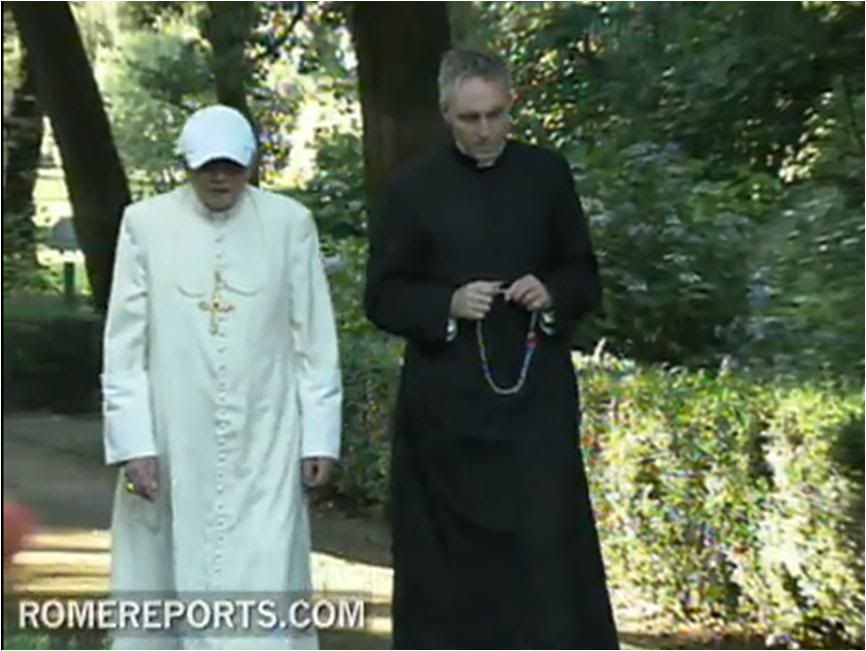
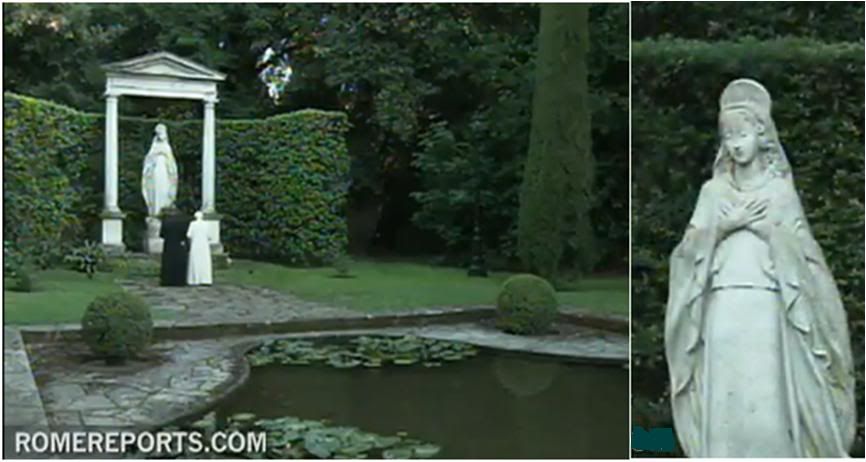
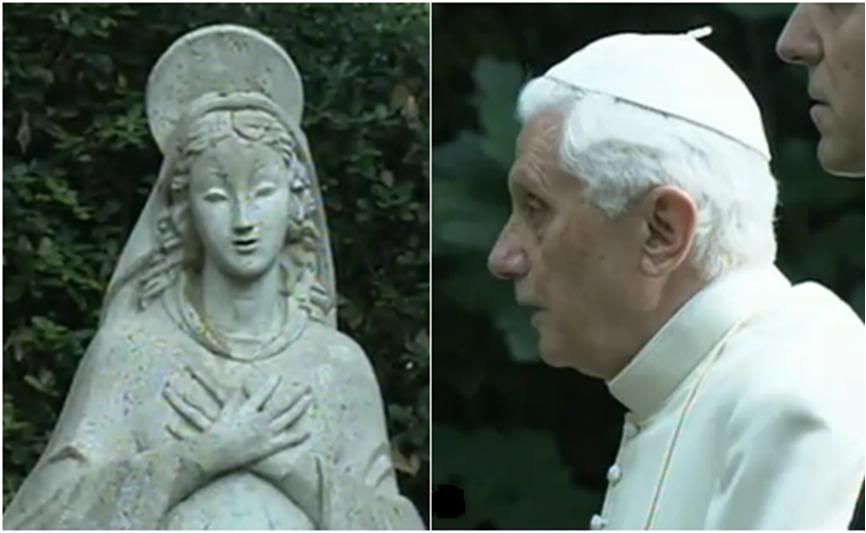
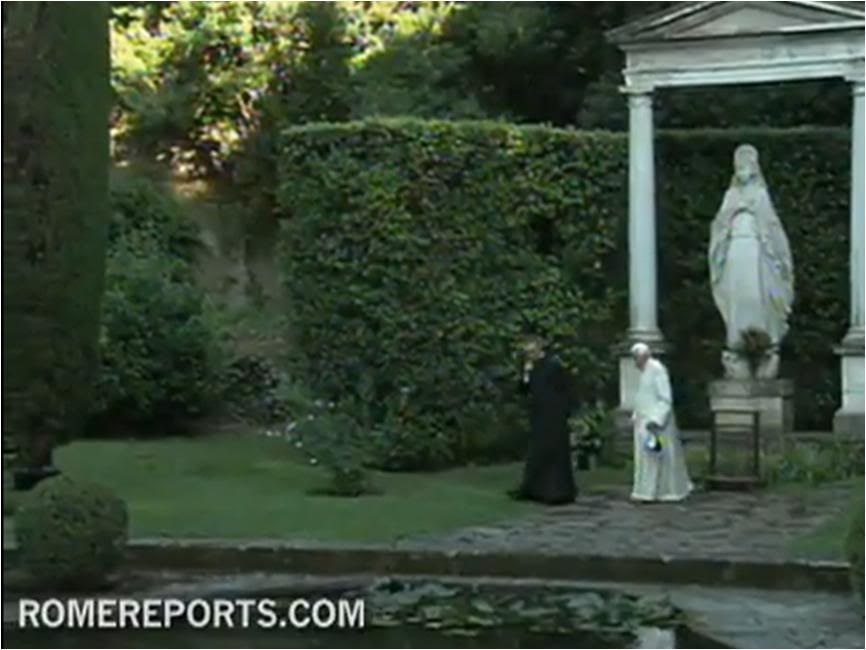
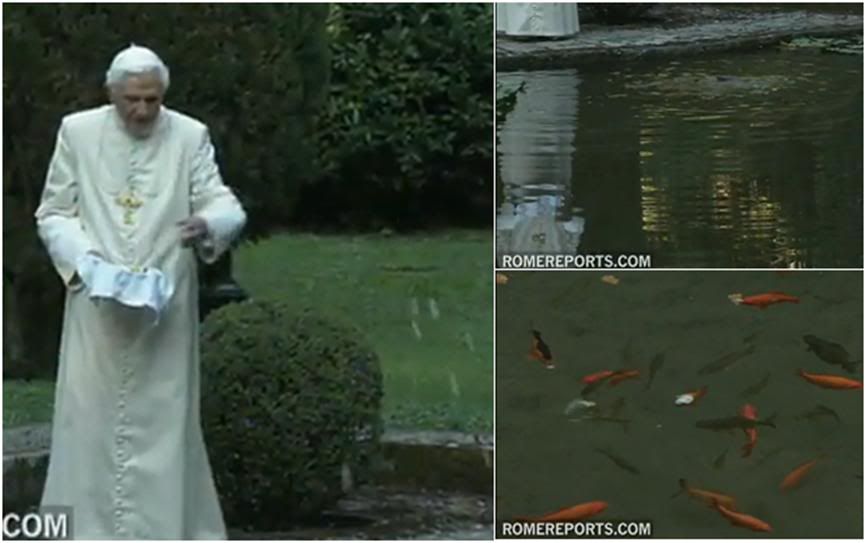
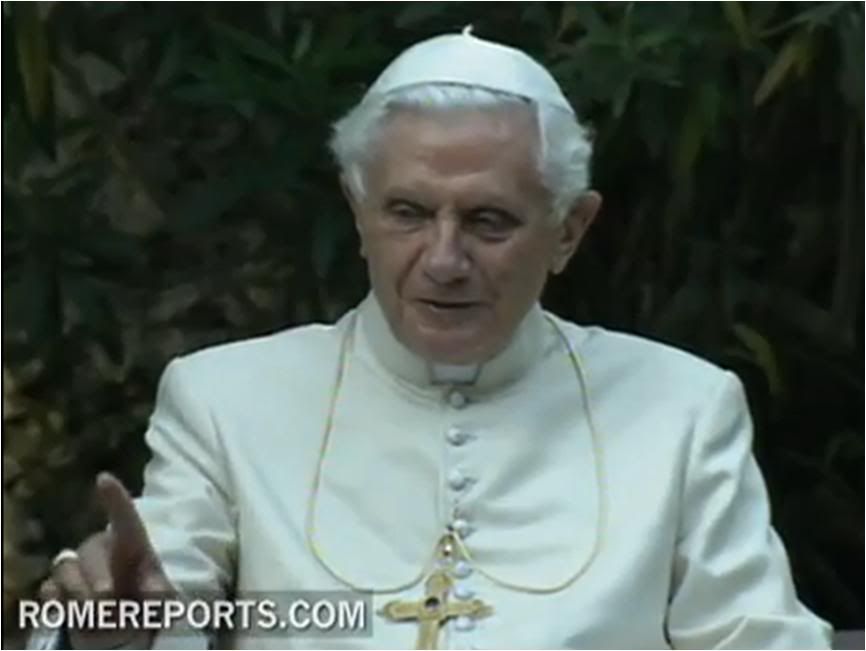
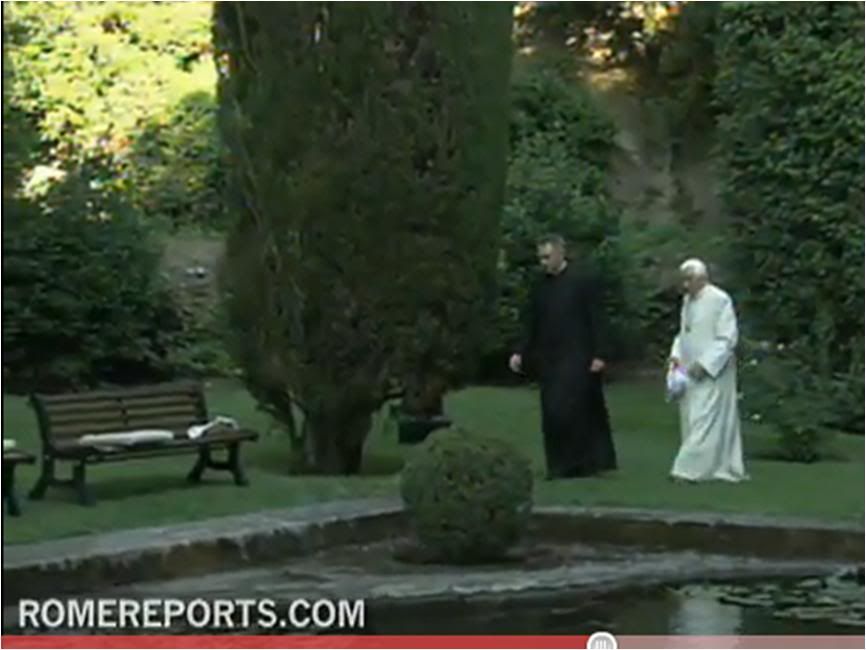
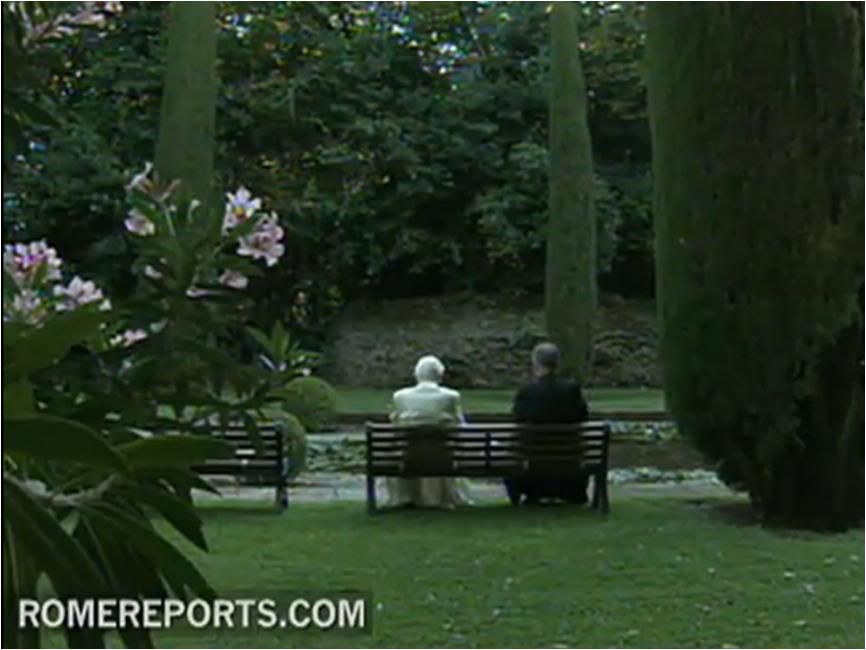 CTV releases videoclip
CTV releases videoclip
from Castel Gandolfo
by Salvatore Izzo

CASTEL GANDOLFO, July 23 (Trasnlated from AGI) - The Centro Televisivo Vaticano today released a video clip of the Pope in Castel Gandolfo showing him in his study and on a walk through the gardens with his secretary, Mons. Georg Gaenswein,
Vatican spokesman Fr. Federico Lombardi said, "Benedict XVI already appears recharged, and has dedicated himself to reading and study which are demanding but not tiring for him".
In particular, Lombardi said, "He has started to work on the third volume of his major work on Jesus. Earlier this year, he submitted the manuscript for the second volume on the Passion and the REsurrection to the publishers, who are now working on translations and expect to publish it by spring next year. The third and last volume will be dedicated to the Gospels of Jesus's youth."
"Besides the new book, he has also been reviewing the material for the next volume to be published of his Opera Omnia (Complete Works), a project begun several years ago and which he very much wants to complete".
[It goes without saying that the Holy Father would also be working on his discourses for the trip to Carpineto on Sept. 5 to mark the bicentennial of Pope Leo XIII's birth, to the United Kingdom in September, and to Spain in November.
P.S. Mea culpa!, it seems Fr. Lombardi said all that in his weekly editorial which I failed to check out before translating the AGI report:]
The Pope's vacation

July 23, 2010
Days ago the Pope began working on the third volume of his great work on Jesus. The manuscript for the second volume, dedicated to the Passion and Resurrection, was handed in for publishing some months ago. Currently we are preparing the translations and editions in different languages, which are expected to arrive in bookstores next spring. Now Benedict XVI has put his hand to the third and last part, devoted to the "Infancy narratives" in the Gospel.
As the faithful can see for themselves at the Sunday Angelus, after a few days at Castel Gandolfo, Benedict XVI already appears refreshed and smiling. [Not that he was ever unsmiling before he started his vacation, Fr. Lombardi!]
He immediately began to devote himself to reading and study, which although demanding, is not tiring. And now - as I mentioned – he has started working towards the completion of his work on Jesus. It is clear that it is particularly important for him to bring this great project, which he first began years ago, to a conclusion.
In the Preface to the first volume, the Pope recalled that he started to work "during the summer of 2003”, that he gave final form to the first four chapters in August 2004, and he continues: "After my election as Bishops of Rome, I used all my free time to pursue the book".
Many interventions at the Synod of Bishops on the Word of God highlighted the crucial importance of the Pope's book as a model for a theological and spiritual reading of the Gospels, as a guide for believers to meet - through the Gospels - the person of Jesus.
As the Pope himself affirms, "the real Jesus, the historical Jesus in the proper sense". He helps us to encounter Jesus!
We are at the heart of the service of St Peter’s Successor to the Church and men of all time. This is what Benedict XVI has dedicated his "vacation time" to.
[Modificato da TERESA BENEDETTA 23/07/2010 22:25] |
| |
 23/07/2010 19:54 23/07/2010 19:54 |
|
| | | OFFLINE | | Post: 20.658
Post: 3.296 | Registrato il: 28/08/2005
Registrato il: 20/01/2009 | Administratore | Utente Master | |
|

 Decree says papal delegate
Decree says papal delegate
will supervise Legion from
top to bottom for the Pope -
but leadership remains

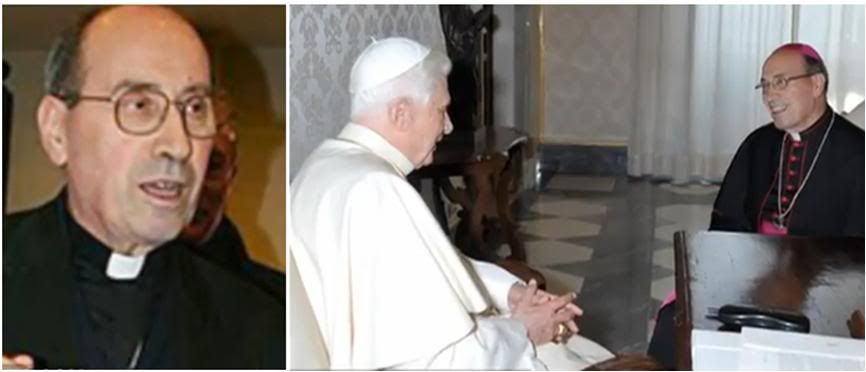
July 23, 2010 - The papal delegate to the Legion of Christ, Archbishop Velasio De Paolis, is the person responsible for the Congregation. Vatican Secretary of State Tarcisio Bertone clarified this in a decree sent to the Order to explain the delegate's role.
Velasio De Paolis exercises authority on behalf of the Pope over all the Legionaries of Christ, from its general director Alvaro Corcuera to its last religious.
While De Paolis is delegate, the superiors of the institute will remain in office, but will have to run their decisions by the papal delegate. He will then decide whether or not to approve them.
The delegate can denounce acts of the superiors of the institute if he considers it necessary. The Holy See reserves the ability to relieve the superiors without having to explain why.
Bertone clarified in the document that the main task of the delegate is to “direct, monitor and carry out the revision of the Constitutions.”
Bertone says that a committee must be formed “as soon as possible” to review the Constitution. De Paolis will chair the committee and it will include participation of all the members of the Congregation.
If the delegate sees the need to study and broaden certain topics, whether of people or things, study commissions can be undertaken.
De Paolis will not be alone in developing this work. He will enlist the help of four close advisers, who have yet to be named. The advisers specifically will visit other communities.
This decree, reviewed by Benedict XVI, leaves no doubt of the role of Archbishop Velasio De Paolis. He will have the important task of solving the grave problems caused by the congregation's founder
Marcial Maciel.
The above report is apparently based on a copy of the decree signed by Cardinal Bertone on July 9 and published today on the website of Regnum Christi,

www.regnumchristi.org/english/articulos/articulo.phtml?se=362&ca=966&te=707&id=30420&cse...
the lay arm of the LC [possibly also on the LC main site itself, but I have not chekced it out]. Here is Regnum Christi's unofficial translation of the original decree in Italian:
DECREE
MODALITIES OF FULFILLMENT
OF THE OFFICE OF PAPAL DELEGATE
FOR THE CONGREGATION OF THE LEGIONARIES OF CHRIST
I. In his letter of June 16, 2010, Pope Benedict XVI:
- appointed His Excellency Archbishop Velasio De Paolis, CS, Titular Archbishop of Telepte and President of the Prefecture for the Economic Affairs of the Holy See, as his Delegate for the Congregation of the Legionaries of Christ;
- conferred on him the responsibility of governing this religious institute in his name “for as long as it takes to complete its path of renewal and lead it to the celebration of an extraordinary general chapter, whose main purpose will be to bring to completion the revision of the Constitutions”;
- considered the “need and urgency of a path of in-depth revision of the Institute’s charism” and expressed his “desire closely to accompany, sustain, and guide this process” through his own personal Delegate for that Religious Family, who would both be a concrete sign of his closeness and act in his name;
- left for a specific Decree “some further modalities regarding the fulfillment of this Office”.
II. Now, by this Decree, Cardinal Tarcisio Bertone, Secretary of State, issues the following specifications and instructions approved by the Supreme Pontiff regarding the modalities in which the Papal Delegate for the Congregation of the Legionaries of Christ will fulfill his Office:
1. The broad authority granted by the Holy Father to the Papal Delegate, to be exercised in the name of the Supreme Pontiff himself, covers the entire institute. It extends over all the superiors at the various levels (general, provincial, and local), all communities, and the individual religious. This authority regards all the problems proper to the religious Institute and the Delegate may always exercise it when in his judgment it is necessary for the good of the institute itself, even overruling the Constitutions.
2. The superiors of the Institute at every level exercise their authority according to the Constitutions and under the authority of the same Papal Delegate. Therefore, they remain in their positions, ad nutum Sanctae Sedis, unless it becomes necessary to provide otherwise.
3. The Institute’s superiors are to act in communion with the Papal Delegate. He is to be informed of the life of the institute, in particular the most important matters, and in addition, only he can approve the decisions of the general government itself: decisions regarding persons (admission to novitiate, profession, priesthood; appointment and transfer of personnel); apostolic and formation choices (seminaries, academic institutions, schools), and extraordinary administrative matters or the disposal of assets.
4. If necessary, the Delegate himself may act firsthand or indicate the decision to be made in specific instances.
5. Everyone has open access to the Delegate and all can deal personally with him. The Delegate, in turn, has the power to intervene wherever he sees fit, including in the internal government of the Institute, on all levels.
6. As he goes about his task, the Delegate will have four personal advisors to aid him in carrying out his work according to the circumstances and possibilities. These aides may be assigned specific tasks, particularly visits ad referendum. With their help, the Papal Delegate will identify, discuss, and clarify the principal topics as they arise during the process he is called to lead.
7. Whenever it becomes evident that certain topics, regarding either persons or things, need to be studied more deeply, the Papal Delegate may appoint study committees using either personnel internal to the Congregation of the Legionaries or competent external persons.
8. At his own discretion, when it seems opportune or necessary, he may select someone other than his advisors to study a point or make a visit ad referendum.
9. The paramount task of the Papal Delegate is to initiate, accompany, and complete the revision of the Constitutions. This implies a profound knowledge of the Congregation of the Legionaries, their history and development. All members of the Institute must collaborate in the revision of the Constitutions, both as individuals and communities, following a plan to be drawn up and activated from the outset. Therefore, a Commission for the revision of the Constitutions is to be created as soon as possible on the various levels of the Institute, with the participation especially of the members of the Institute itself, who must feel personally responsible for revising and rewriting their own plan of gospel living, always in harmony with the teaching of the Church. The president of the central Commission for the revision of the Constitutions will be the Papal Delegate himself.
10. The Papal Delegate coordinates the Apostolic Visitation to the Regnum Christi Movement, following the indication of the Holy See.
11. Appeals against acts of the superiors of the Institute will be directed to the Papal Delegate himself; regarding acts of the Papal Delegate, it will be possible to appeal to the Holy Father.
From the Vatican, July 9, 2010
Cardinal Tarcisio Bertone
Secretary of State
What does it say of the regular Vaticanistas that it takes ROME REPORTS to give the first news of Cardinal Bertone's implementing decree - which was not otherwise released by the Vatican itself? It's not as if they are overworked with their regular coverage - it's the summer doldrums and the Pope is on vacation! Even the usually super-motivated John Allen used his weekly column today
ncronline.org/blogs/all-things-catholic/vatican-literacy-quiz
for a 10-question trivia quiz - not so trivial really - to test entry-level knowledge about the Catholic Church that an aspiring religious beat reporter should know, at the very least! In other words, he had apparently found nothing to report... And all the while, there was this decree from Cardinal Bertone...
However, expect a lot of flak - from outside the Church and from staunch Catholic commentators like George Weigel and Sandro Magister - for the decision to leave the current LC leadership in place! Granted they are all directly answerable to Mons. De Paolis now, the implementing decree is hardly the clean sweep that would have been commensurate to the Augean stables that the LC leadership had become! Obviously, the Holy Father is giving them a chance to redeem themselves, but as a layman looking on, it looks like they are getting a reprieve for all their apparent cover-up and lying - or at the very least, lack of good faith - all these years about Fr. Maciel.
[Modificato da TERESA BENEDETTA 23/07/2010 22:29] |
| |
 23/07/2010 23:07 23/07/2010 23:07 |
|
| | | OFFLINE | | Post: 20.659
Post: 3.297 | Registrato il: 28/08/2005
Registrato il: 20/01/2009 | Administratore | Utente Master | |
|
 BTW, I am grateful to the blog MESSA IN LATINO for articulating the same objection I posed earlier to Fr. Lombardi's unnecessary and in any case, too defensive statement denying that the Holy Father could ever have, God forbid!, celebrated the traditonal Mass in private since he became Pope! Here is what the blogger had to say. (He makes earlier comments about other recent Vatican communications moves that he finds questionable - including announcing the updated norms on all the offenses against the faith, morals and the sacraments that are under the competence of the CDF. On which point, I disagree heartily - on both practical and logical grounds - - as I have explained more than once before.)
Re Fr. Lombardi's denial that the Pope
BTW, I am grateful to the blog MESSA IN LATINO for articulating the same objection I posed earlier to Fr. Lombardi's unnecessary and in any case, too defensive statement denying that the Holy Father could ever have, God forbid!, celebrated the traditonal Mass in private since he became Pope! Here is what the blogger had to say. (He makes earlier comments about other recent Vatican communications moves that he finds questionable - including announcing the updated norms on all the offenses against the faith, morals and the sacraments that are under the competence of the CDF. On which point, I disagree heartily - on both practical and logical grounds - - as I have explained more than once before.)
Re Fr. Lombardi's denial that the Pope
has ever said the TLM in private:
For the Vatican's disastrous communications system,
it seems more important at any cost to defend
the Pope from any possible charge of traditionalism!
Translated from

July 23, 2010
...This blog was the first to report - pardon the lack of modesty - the contents of a little-reported news conference given recently by Mons. Bernard Fellay [superior-general of the FSSPX) in a Brazilian city, where he said that the Holy Father and his secretary, Mons. Gaenswein, have probably celebrated the traditional Latin Mass a few times.
Well, the news was picked up by everyone, and suddenly, the ineffable Fr. Lombardi rushed - with a celerity worthy of a major crisis - to tell the Catholic News Service that the Pope only celebrates, or rather concelebrates, the Novus Ordo, in Italian, with his secretary.
He adds, without realizing the absurdity of what he us saying (seeing that he is belying a statement made by Mons. Fellay who certainly knows how to distinguish the TLM from the Novus Ordo) that probably, the 'mistake' comes from the fact that the Pope celebrates the Mass facing the altar in his private chapel!
Nonetheless, why this hasty denial? We know that the Pope is almost literally under 'blackmail' [I think the sense is 'held hostage' by the progressivists] for as long as he does not publicly celebrate the traditional Mass.
But perhaps it is too much for Fr. Lombardi and his fellow advocates of the Novus Ordo that even one voice should be allowed - without having to confirm or deny it - that Benedict XVI could possibly 'under certain circumstances' dare to celebrate the TLM in private!
Meanwhile, let me go on believing - since it hurts no one - that the Pope has said the TLM at least once in his private chapel, if only to show his Memores housekeepers and his valet what they have missed by having been born after Vatican II! And while I understand the prudence that has so far kept him from celebrating the TLM in public, how long will he continue not giving it 'full citizenship' within the realm of papal liturgies itself??? On this one point, I respect his judgment but my mind is too limited to find any justification for what seems to me like inconsistency from this most consistent of Popes... There has to be a significant reason I am unable to see but which appears clear to Mons. Fellay and other traditionalists who would otherwise have been expressing their remonstrations in no uncertain terms!
[Modificato da TERESA BENEDETTA 24/07/2010 05:42] |
| |
 24/07/2010 13:11 24/07/2010 13:11 |
|
| | | OFFLINE | | Post: 20.660
Post: 3.298 | Registrato il: 28/08/2005
Registrato il: 20/01/2009 | Administratore | Utente Master | |
|
 Saturday, July 24, 16th Week in Ordinary Time
Saturday, July 24, 16th Week in Ordinary Time
 ST. CHARBEL MAKHLOUF (Lebanon, 1828-1898), Maronite Monk and Hermit
ST. CHARBEL MAKHLOUF (Lebanon, 1828-1898), Maronite Monk and Hermit
Born Youssef Makhlouf to a mule driver and his wife, the future saint joined the monastery of St. Maron at age 23, taking his monastic name from a second-century Lebanese saint. He was ordained a priest in 1859 and quickly gained fame for his spirituality and example. He was particularly devoted to the Blessed Sacrament, often spending hours in adoration. He ministered the sacraments to the surrounding villages despite the difficult terrain and climate of the area (more than 4500 feet above sea level). In 1875, he decided to be a hermit, following the example of St. Maron (who lived in the 5th century) and remained a hermit for 23 years until his death. Miraculously, he survived the severe winters without warm clothing or heating for his habitation. There was heavy snowfall on the day he died, Christmas Eve, but the following day, as his fellow monks prepared to bury him at the monastery, the storm stopped, enabling the villagers to attend his funeral. His tomb quickly became a place for pilgrimage and miraculous cures. These intensified after his body was exhumed in 1950 preparatory to his beatification and found to be intact. Pius XI had proposed his beatification in 1935. Paul VI beatified him in 1966 at the closing of the Second Vatican Council, and canonized him 10 years later.
Readings for today's Mass: www.usccb.org/nab/readings/072410.shtml
OR today.
 'The Pope's working vacation in Castel Gandolfo'
Two weeks since he began his summer residence at Castel Gandolfo, the Vatican released a short video and still photographs of the Pope. Other Page 1 stories: A commentary on the stress tests to which 91 European banks will be subjected by the European Union; the International Court at the Hague upholds the independence uniltarally proclaimed by Kosovo in 2008 but Serbia continues to contest it; Venezuela's President Chavez breaks off diplomatic relations with neighboring Colombia, claiming graphic documentation was falsified to show Venezuela has been harboring Colombian guerrillas in a border province; China has stopped the oil leak from a pipeline that exploded in the northeast port city of Dalian but now has to clean up 450 square kilometers of oil slick on the Yellow Sea.
'The Pope's working vacation in Castel Gandolfo'
Two weeks since he began his summer residence at Castel Gandolfo, the Vatican released a short video and still photographs of the Pope. Other Page 1 stories: A commentary on the stress tests to which 91 European banks will be subjected by the European Union; the International Court at the Hague upholds the independence uniltarally proclaimed by Kosovo in 2008 but Serbia continues to contest it; Venezuela's President Chavez breaks off diplomatic relations with neighboring Colombia, claiming graphic documentation was falsified to show Venezuela has been harboring Colombian guerrillas in a border province; China has stopped the oil leak from a pipeline that exploded in the northeast port city of Dalian but now has to clean up 450 square kilometers of oil slick on the Yellow Sea.
The Pope has named three new members to the Congregation for the Causes of Sainthood:
- Mons. Fortunato Baldelli, Major Penitentiary
- Mons. Raymond Leo Burke, Prefect of the Supreme Tribunal of the Apostolic Segnatura
- Mons. Antoni Stankiewicz, Dean of the Roman Rota.
The Vatican also released the papal letter naming Cardinal Marc Ouellet, Prefect for the Congregation of Bishops,
as his personal representative to the fourth centenary celebrations in Chapel Island, Nova Scotia, Canada on August 1,
of the baptism of Great Chief Mambertou of the Miqmaq Indians
|
| |
 24/07/2010 14:04 24/07/2010 14:04 |
|
| | | OFFLINE | | Post: 20.661
Post: 3.299 | Registrato il: 28/08/2005
Registrato il: 20/01/2009 | Administratore | Utente Master | |
|
 At the residence in Castel Gandolfo:
At the residence in Castel Gandolfo:
The Pope's working vacation
Translated from
the 7/24/10 issue of

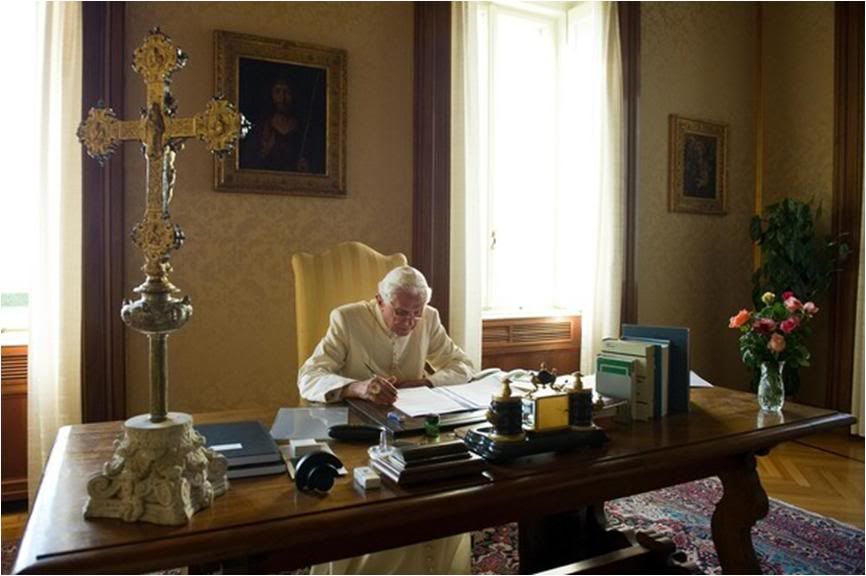
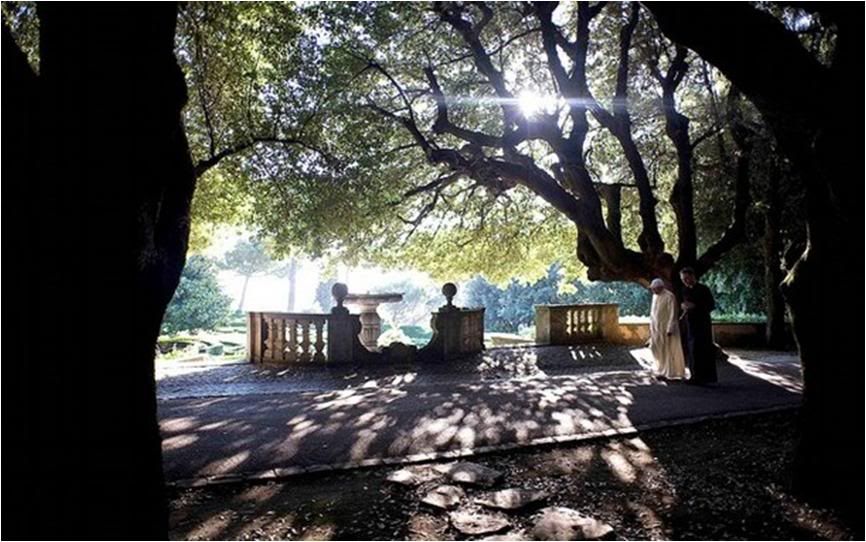
Benedict XVI's summer stay in Castel Gandolfo is entering its third week - surrounded by the beauty of Nature and by history, as he himself said on the day he arrived here last July 7.
Apart from the fact that all his private and public audiences have been suspended in July, the Pope's day is not much different from his routine at the Vatican, though it starts somewhat later.
The Pope spends much time reading, studying and writing, punctuated by meditation and prayer, listening to music and playing the piano, and long afternoon walks in the gardens of the Pontifical Villas with his private secretary, Mons. Georg Gaenswein.
The Pope still has to look through his daily correspondence and important documents sent on daily from the Vatican, and he has been preparing for major events in the coming months.
Above all, his apostolic trips: to Carpineto Romano (Sept. 5), to the United Kingdom (Sept 15-19), to Palermo (Oct. 3), and to Spain (Nov. 6-7) - and all the papal texts that have to be written for these trips.
Then there is the Special Assembly for the Middle East of the Bishops' Synod to be held at the Vatican Oct. 10-24.
He must also finalize his Post-Synodal Apostolic Exhortation following the Special Assembly on the Word of God last year, as well as the Message for World Youth Day 2011.
At the end of July, he expects a working visit from his Secretary of State, Cardinal Tarcisio Bertone, and a few days later, the arrival of his brother, Mons. Georg Ratzinger, who will be in Castel Gandolfo for all of August.
On Aug. 28-29, Castel Gandolfo will host the annual reunion-seminar of the Ratzinger Schuelerkreis, at which the Pope and his former doctoral students will discuss this year the hermeneutic of Vatican-II, based on the Pope's historic address to the Roman Curia in December 2005.
[The articles goes on to quote generously from the editorial by Fr. Lombardi for Vatican Radio and CTV's Octavo Dies program, posted on this page yesterday. Fr. Lombardi talks about the Pope's work on a third volume of JESUS OF NAZARETH.]
The photographs released by the Vatican were taken by OR photographers Francesco Sforza and Simone Risoluti. (Too bad they didn't release any 'baseball cap' stills]:
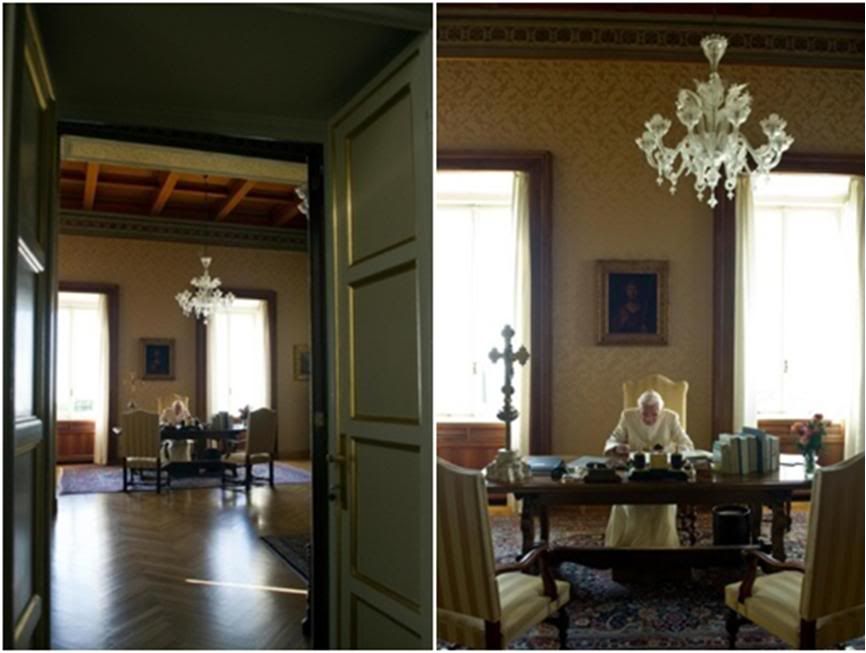
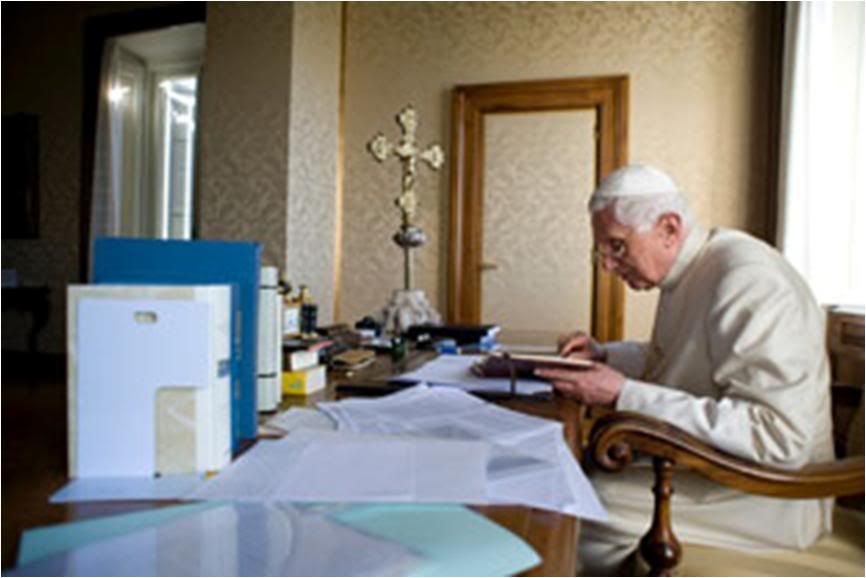
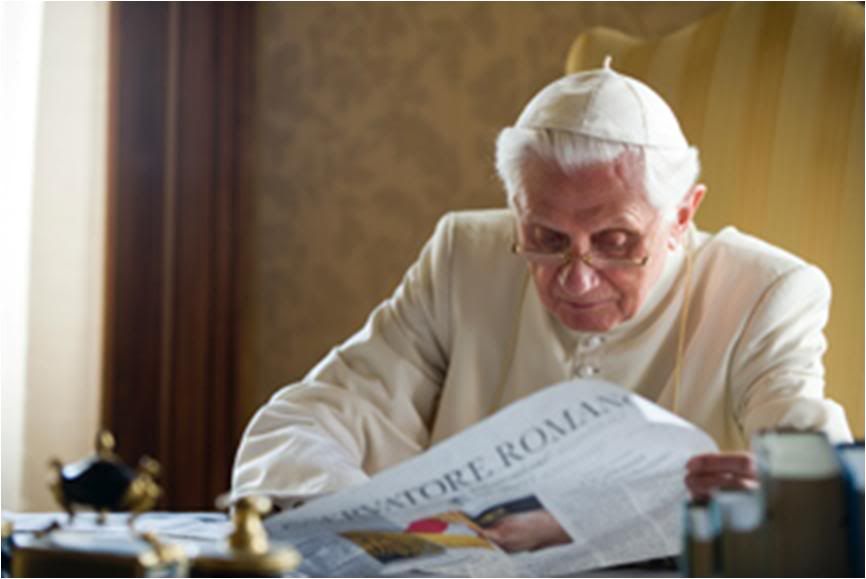
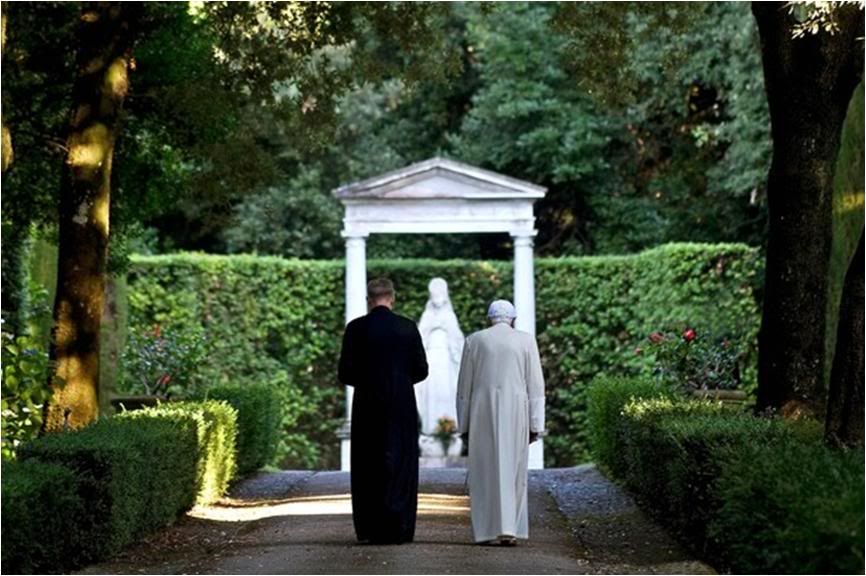
 Lella on her blog points us to another version of the video, from Repubblica, which starts with a longer segment of the Pope's walk in the Gardens (with a few seconds of see-through cassock), in which he moves much more normally (I thought he moved a bit slow in the earlier video):
tv.repubblica.it/mondo/il-papa-in-vacanza-col-cappellino-da-baseball/50938?video=&re...
NB: There's a few seconds of commercial preceding the clip.
Lella on her blog points us to another version of the video, from Repubblica, which starts with a longer segment of the Pope's walk in the Gardens (with a few seconds of see-through cassock), in which he moves much more normally (I thought he moved a bit slow in the earlier video):
tv.repubblica.it/mondo/il-papa-in-vacanza-col-cappellino-da-baseball/50938?video=&re...
NB: There's a few seconds of commercial preceding the clip.
[Modificato da TERESA BENEDETTA 25/07/2010 01:11] |
| |
 25/07/2010 01:00 25/07/2010 01:00 |
|
| | | OFFLINE | | Post: 20.662
Post: 3.300 | Registrato il: 28/08/2005
Registrato il: 20/01/2009 | Administratore | Utente Master | |
|
 For now, at least, and in the Italian media, Italy's Panorama newsweekly magazine has succeeded in opening a new front in the assault against the Church for the sins of some its ministers. Not pedophilia this time but probably what is its most general underlying cause - the inability of some priests to discipline their carnal lusts, in this case, homosexual. Which, in turn, leads to the widespread secular myth that at least 50% of Roman Catholic priests are homosexual, as many books and articles claim.
For now, at least, and in the Italian media, Italy's Panorama newsweekly magazine has succeeded in opening a new front in the assault against the Church for the sins of some its ministers. Not pedophilia this time but probably what is its most general underlying cause - the inability of some priests to discipline their carnal lusts, in this case, homosexual. Which, in turn, leads to the widespread secular myth that at least 50% of Roman Catholic priests are homosexual, as many books and articles claim.
Surprisingly, in the same issue, Ignacio Ingrao, the Panorama commentator whose portraits of the Vatican purportedly from a privileged inside view are usually unflattering, has a commentary that presents the context which is completely ignored by the main article - whose voyeuristic and prurient intention may be deduced from the lurid cover illustration showing the close-up of a priest holding a rosary, but to whose hairy wrists a woman's hands with pink fingernails have been photoshopped.
Nonetheless, Ingrao manages to work in some 'poison' towards the end. Here first is Ingrao's commentary: ....
Benedict XVI's painful crusade:
Since 2005, zero tolerance for
homosexual priests and seminarians
by IGNACIO INGRAO
Translated from

Issue of July 23, 2010
I think the sense of the headline is too sweeping. Especially in the case of those concerned who are already priests, the problem is not whether they feel themselves to be homosexual or not - but whether despite their self-identification, they continue to live up to their vow of chastity. Exactly the same heroic, almost superhuman, discipline is required of them that is required of priests who have normal heterosexual urges.
He has said he will use the rod against priests who 'behave in ways unworthy of priestly life".
When he addressed some 15,000 priests from all over the world who had gathered in St. Peter's Square for the concluding rites of the Year for Priests last June 11, Benedict XVI made it clear: "The Church can no longer tolerate in its priests 'orientations which are really disorientations". Among this, homosexuality.
No one had ever heard him sound so firm and resolute. It was the latest act of a crusade he launched almost right after the Conclave that elected him Pope. On August 31, 2005, Benedict XVI ordered the publication of an Instruction from the Congregation for Catholic Education that he had approved on May 31 - barely six weeks since he became Pope. The Instruction effectively closes admission to seminaries for homosexuals.
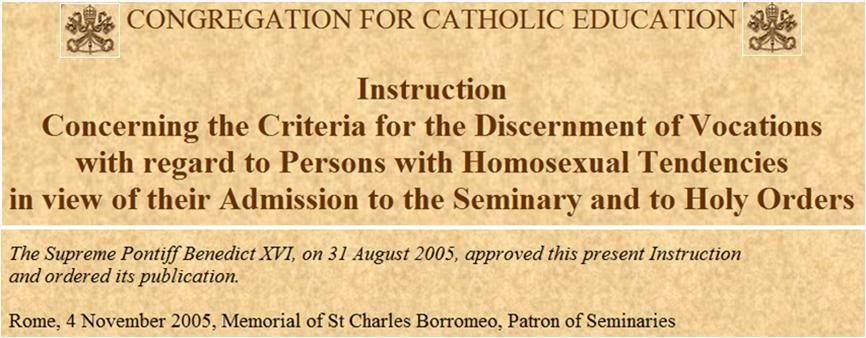
The document immediately raised outrage among the associations for gay rights, especially since it is leaves no room for equivocation in its statement that the Church considers 'homosexual acts' to be 'grave sins' because "they are intrinsically immoral and contrary to natural law".
That is why, it makes clear, "the Church cannot admit to the seminary whoever practises homosexual acts, presents profoundly-rooted homosexual tendencies or supports the so-called 'gay culture'."
Existing canon law provides that if an ordained priest is caught 'sinning against the Sixth Commandment' ['Thou shalt not commit adultery', but which has always been understood to cover all impure sexual acts and thoughts] , the punishment is suspension from priestly duties, to which if the offense is repeated after the first admonition, other punishments may be added up to dismissal from the clerical state" (Art. 1385 of the Code of Canon Law).
Benedict XVI soon followed up the Instruction with action. The first to be struck out was the secretary of an important Vatican congregation who was forced to resign because of his frequent and widely known nocturnal assignations.
Shortly afterwards it was the turn of the man who had been a bureau chief in the Congregation for the Clergy, Mons. Tommaso Stenico, a clinical psychologist, popular broadcaster and writer. [Ironically, he also edited two volumes putting together Benedict XVI's various addresses and responses to priests and seminarians.]
In October 2007, an Italian TV channel broadcast video taken by a hidden camera showing Stenico in his office with a young man he met on the Internet. He claimed that he was doing research on the subject and that he had been set up.
Nonetheless, the Vatican dismissed him from his position and any association with the Roman Curia.
The same thing happened to an Italian archbishop who was relieved of the presidency of a dicastery.
Likewise, an investigation was deemed necessary on the eve of the nomination of a brilliant theologian archbishop to a prestigious Curial position. The case was shelved for lack of evidence.
And recently, a young Nigerian seminarian who was a member of one of the Vatican choirs, was dismissed from the choir when it was learned that he had procured boys for Italian wheeler-dealer Angelo Balducci, who was named a 'Gentleman of His Holiness' during the previous Pontificate. [The Vatican says Balducci will no longer be listed among the 'Gentlemen'.]
To further reinforce his prohibitions and exhortations on strict screening of seminarians, Benedict XVI authorized the Congregation for Catholic Education in 2008 to publish guidelines enjoining all seminaries to use psychological experts and tools to determine the emotional maturity and sexual orientation of candidates for the priesthood.
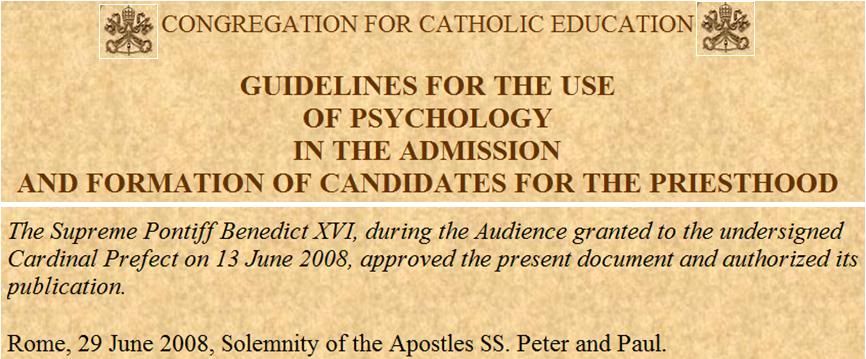
But there has always been controversy on this issue. Some in the Curia claim that the Pope has played favorites ,in that some who are believed to be just as culpable as those who have been dismissed from the Curia have remained in place because they are 'powerful'. [That is a major accusation against the Pope. Ingrao owes it to the reader to name names if indeed there is any ranking member of the Curia whose 'active' homosexuality is tolerated!)
Meanwhile, I had no choice but to read the Panorama article - all five pages of it. Someone is bound to make 'hot tamales' of it to peddle in the Anglophone press, anyway.
And it does make the assumption that the three men 'documented' by the writer and his accomplice represent the priests of Rome, since the reporter also quotes - a-critically and unquestioningly - one of the priests claiming that '98% of all the priests he knows are homosexual'.
Of course, it is simply revolting that the reporter knowingly used his accomplice as bait for the priests and had him take part in sexual encounters with them that were filmed and now posted online. I have not bothered to look at the videoclips but the still photo for one of the encounters is bad enough. The article itself thankfully does not describe what happens after the writer says something generic like "He took him to the bedroom, undressed and lay on the bed". He does describe matter of factly the suggestive moves done with clients - in this case, one of the priests - during seminude dancing in a gay club.
I have translated the teaser account online for the article:
'Le notte bravi dei preti gay':
A major investigation
Translated from

Issue of July 23, 2010
An investigation with hidden TV cameras, followed by minutious verifications and careful checks. For 20 days, Panorama reporter Carmelo Abbate, with the help of a gay friend, infiltrated the 'nights on the town' of some priests who have been conducting a double life in Rome: by day, they are priests in cassocks; by night, they take off the tunic and become perfectly integrated into the homosexual circles of the capital.
[In the article, the friend is identified as a gay young man who met one of the priests, Paul, in a sauna one week earlier and had been invited by him to attend a gay night in a Rome club. The youth's telephone call to the reporter about this appointment with the supposed priest prompted the reporter to plan his 'investigation' posing as the young man's 'fiance'.]
The result is a field investigation which allowed the unprecedented revelation [Revelation??? Surely, homosexual priests who indulge themselves in violation of their vows are nothing new] and in many cases, disturbing: priests taking part in nocturnal orgies with male escorts; who have sexual relations with casual partners; who are habitues of Internet gay chats and appointments.
Panorama has identified numerous cases [How numerous is numerous? Dozens? Hundreds?] and tells the story of three in particular, Paul, Carlo and Luca (the names are invented to protect their identities).
The first, a 35-year-old Frenchman, met the reporter and his friend on Friday, July 2, at a gay feast in a bar in Testaccio. With him were two male escorts whom he had sent for from Sardinia and paid to dance semi-nude with himself and other partners (and then had sex with some of them). Also present was Carlo, the second priest, about 45-50 of age.
The night ended in Paul's house where the reporter's gay friend had sex with the priest, an encounter that was filmed by our hidden TV camera.
The following night, Paul and Carlo arranged to meet the reporter and his friend at the Gay Village, another club where the two priests seemed very much at home. On this occasion, Carlo disappeared a few times, saying he did so to avoid encountering priests and catechists who might know him. [A convenient way to insinuate that the Gay Village is populated by 'other priests and catechists' besides just the two priests with the reporter.] The night closed in the same way as the previous night.
The next day, Sunday, July 4, Paul said Mass at an altar in his residence for the reporter and his friend. Panorama later verified that Paul was indeed a priest.
Our first one-on-one meeting with Carlo was in a downtown restaurant whose usual clientele is gay, including many gay priests, according to Carlo, who pointed to two men at the next table, saying one of them was a priest and that the two were 'engaged'.
Carlo also claimed that at least 98% of the priests in his acquaintance are homosexual, but that the Church today has an 'intransigent' part that refuses to look at reality, and a 'more evangelical' part which recognizes and accepts the phenomenon of homosexual priests.
After that lunch, Carlo took the reporter's friend to his apartment which adjoins a major building belonging to the Church. They had a sexual interlude, also filmed by our hidden camera.
We also filmed Carlo when he said Mass at a church not far from his apartment.
All the video films to support this story have been available at Panorama online starting July 23.
[The summary says nothing about the third 'priest', Luca. In the article, the reporter claims that they were unable to establish whether he was really a priest, because they could not contact him again after the first encounter when he brought them home to 'his apartment', said to be on the second floor of a building attached to a church, where he promptly had sex with the reporter's friend. The reporter says no one in the building seemed to know anything about him.
The two presumably verified priests, Paul and Carlo, both claim to have served Mass for the Pope at the Vatican - Paul claiming to have "he celebrated Mass for him for a whole year".] [The writer just quotes him so uncritically! How exactly do you celebrate Mass 'for the Pope'? It's not as if the Pope has to have someone else celebrate his daily Mass for him - and in any case, he says his daily Mass in his private chapel with only his household.]
Paul reportedly goes on to say that the Pope is not as bad as the media portray him and that he is burdened by having to carry on Wojtyla's legacy. He apparently had nothing worse to say about the Pope, thank God!, but volunteered to say that when Benedict XVI took over the papal apartments, he did not ask for anything special other than to have the walls repainted, and that any additional furniture he needed was ordered from Ikea. And he praised him for channelling all the royalties from his books to various charities. (All of that, except perhaps the Ikea bit, has been common knowledge, and does not prove Paul has a privileged position in the Apostolic Palace. Now, if he had said something about a cat...)
An additional video online has the deputy editor of Panorama saying that he has the full names and addresses of the three priests and some other practising homosexual priests in Rome, if the Church wishes to confirm the Panorama story. (But wait! I thought they couyld not confirm Luca's identity!)]
Pardon my constitutional intolerance, but why should homosexuals who have no intention of observing chastity persist in remaining priests? Either they have deluded themselves into thinking that there is nothing wrong with their double life and they can do as they please because there is nothing wrong with homosexual acts; or they derive additional perverse pleasure in thumbing their noses at the 'rules' of the Church, with heroic visions of helping to break down her Tradition to make her conform to the 'anything goes' amorality of secular society.
Obviously, the Panorama 'shock du jour' is not really an investigation - it cites no facts and figures independently researched about the issue, and it is completely limited to the reporter's observations (supported by videos taken by the hidden camera] and documentation of what the three priests did during the 20 days that he recorded their doings.
[Modificato da TERESA BENEDETTA 26/07/2010 12:34] |
| |
 25/07/2010 02:43 25/07/2010 02:43 |
|
| | | OFFLINE | | Post: 20.663
Post: 3.301 | Registrato il: 28/08/2005
Registrato il: 20/01/2009 | Administratore | Utente Master | |
|
 The Pope will designate
The Pope will designate
Sagrada Familia a basilica;
Barcelona archbishop
reveals proposed program

BARCELONA, Spain, JULY 23, 2010 (Zenit.org).- In addition to blessing the Church of the Sagrada Familia in Barcelona, Benedict XVI will proclaim Antoni Gaudi's church a basilica.
Cardinal Lluís Martínez Sistach, archbishop of Barcelona, revealed this today at a press conference held at midday with some 100 journalists in the Gaudi Room of Barcelona's diocesan museum.
The cardinal explained numerous details of the Pope's November visit to Barcelona, where, in addition to consecrating the church dedicated to the Holy Family, he will visit the school for the disabled of the diocesan foundation Niño Dios.
The apostolic visit to Spain will begin on Saturday, Nov. 6, with the Pontiff's arrival in Santiago de Compostela for the Jacobeo Holy Year. This holy year is celebrated every time his annual feast day on July 25 falls on a Sunday.
Benedict XVI will venerate the tomb of the Apostle James in the Cathedral of Compostela. He will preside at a prayer for invited children, older people and sick persons in the Cathedral and then have lunch with the bishops of northern Spain.
In the afternoon, he will preside at Holy Mass in the vast Plaza Obraidores facing the main facade of the cathedral.
After the Mass, he will leave for Barcelona, where is expected to arrive around 9 p.m. He will be welcomed by a delegation that might include Felipe, the Prince of Asturias and heir to the Spanish throne.
Benedict XVI will spend the night at the Archbishopric of Barcelona, where he is scheduled to arrive at 9:45 pm.
The following morning, Sunday, Nov. 7, the Pope will travel by Popemobile from the archbishopric to the Church of the Sagrada Familia.
Before entering the church, the Popemobile will pass through the surrounding streets so that those gathered around the church will have a chance to greet the Pontiff. Cardinal Martínez Sistach said that as many as 500,000 are expected to gather.
Benedict XVI will enter the church through the southern door on Mallorca street. He will be vested in the sacristy and proceed to solemnly open the bronze doors of the Portico of Glory.
This will be followed by Mass, during which the altar will be dedicated. The Litany of the Saints will be recited followed by the prayer to consecrate the church to God.
Then the altar and the walls will be anointed with holy oil before the first incensing of the newly consecrated altar.
At the end of the Mass, the Pope will go out to the Portico of the Nativity to greet the faithful and pray the midday Angelus, from the same place where John Paul II stood during his visit to Barcelona in 1982.
After the Marian prayer and his address and greetings to pilgrims, the Holy Father will enter the Church again, process the whole length of the church, and unveil the commemorative inscription of the day's event.
The Pope XVI will return to the archbishopric in the Popemobile to lunch with the bishops of eastern Spain.
At 5:15 pm, the Pope will visit the foundation Niño Dios -- dedicated to persons with Down syndrome and other disabilities, This diocesan foundation is run by the Franciscan Sisters of the Sacred Heart.
The Pope will lead a prayer with the students and chat with them and their families, Then he will bless the first stone for a new residence.
Cardinal Martínez said that the Pope had wanted "after blessing the Church of the Holy Family, to be close to those families that are suffering for one reason or another, including those who have sons and daughters with disabilities - those for whom Sagrada Familia could be an icon full of hope".
The Pope will them head back to Barcelona airport for the official farewell ceremony to be attended by the King and Queen of Spain. The Pope and his party will leave for Rome at 9:15 p.m.
I subsequently checked out the website of the Archdiocese of Barcelona which did have a full news release (and photos) of Cardinal Martinez's news conference.
Archbishop of Barcelona calls
for massive citizen participation
during the Pope's visit
Translated from

July 23, 2010
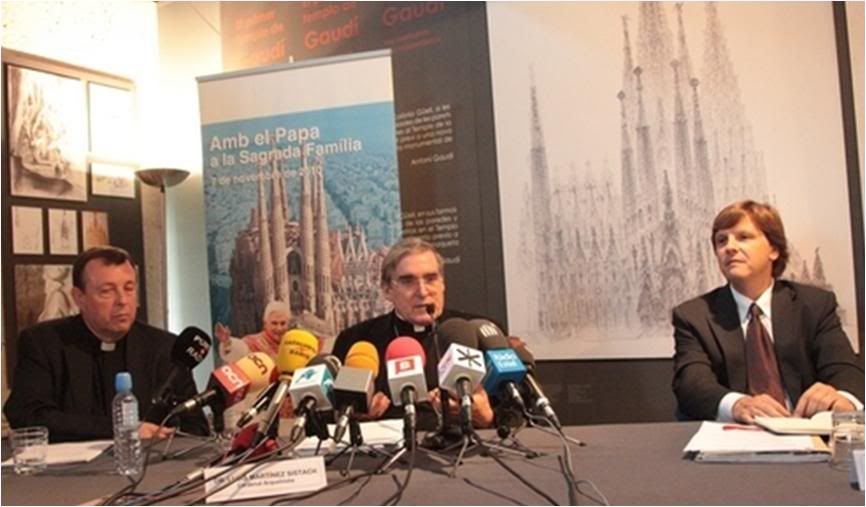
At a news conference on Friday, Cardinal Julio Martinez Sistach, Archbishop of Barcelona, gave details of the program for Pope Benedict XVI's visit on November 7 to dedicate the Templo Expiatorio de la Sagrada Familia, the monumental church designed by Catalan architectural genius Antoni Gaudi and begun 128 years ago.
The cardinal reiterated his invitation to all the citizens of Barcelona and its surroundings to respond to the Holy Father's visit "with a massive civilian presence at the ceremony and in the streets through which the Holy Father will pass".
The Holy Father, along with a multitude of priests, will celebrate the first Mass in Sagrada Familia, whose interior is being completed in time for his visit.
Before the Mass, he will solemnly open the bronze doors of the church's main entrance, called the Portico of Glory. The consecration rites during the Mass will consist of the dedication of the altar with the recitation of the litany of saints as an invocation to all those who preceded us in the faith, the anointing of the altar and the columns, the incensing of the altar and the nave, and the illumination of the church.
At the end of the Mass, the Pope will proceed to the Portico of the Nativity, where, from the same place as John Paul II did in 1982 [when Sagrada Familia was little more than an exterior shell] , he will lead the Angelus prayer to be broadcast worldwide.
He will then return to the interior where he will unveil a commemorative plaque of the dedication and will proclaim the church as a basilica.
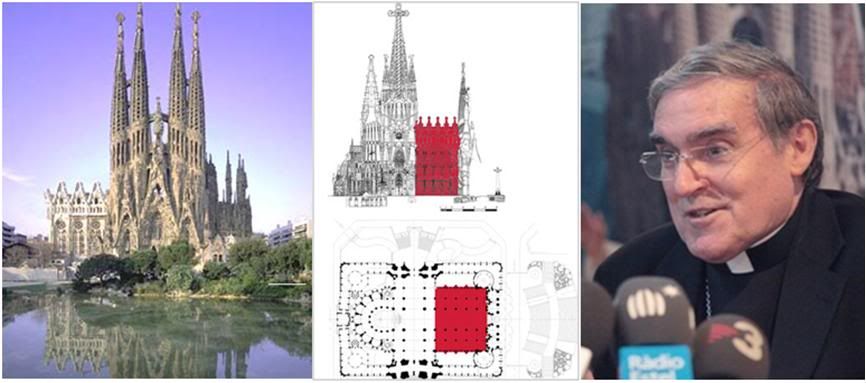 Center diagram indicates the nave (in red) which is the last major part of the church interior being completed in time for the Pope's visit.
Center diagram indicates the nave (in red) which is the last major part of the church interior being completed in time for the Pope's visit.
It will be the sixth basilica in Barcelona - in addition to the Cathedral of Barcelona, and the churches of Santa Maria del Mar, San Jose Oriol, La Merce (Virgin of Mercy), and La Concepcion.
After Mass, the Pope will lunch at the Archbishop's Palace with the bishops and prelates of the region. In the afternoon, he will proceed to the Guinardo neighborhood to visit the Obra del Nino Dios (Work of the Child Jesus), an archdiocesan organization for disabled and handicapped children run by the Franciscan Sisters of the Sacred hearts of Jesus and Mary, where he will meet with the children and their families.
Cardinal Martinez said the Pope had specifically asked to meet with families who find themselves in difficulties "for whom the Templo de la Sagrada Familia can be an icon of hope". He said it was a demonstration of the sensitivity of the Holy Father and the Church to the most needy in society.
In this way, said the cardinal, "Benedict XVI wishes to thank all the diocesan entities for their work and dedication in so many fields and on so many occasions in behalf of Christian families, especially those who are in difficulties".
During his visit to the Obra del Nino Dios, the Holy Father will talk to the children and their families, pray with them, and bless the first stone for a new residence for the wards.
From Nino Dios, the Pope will proceed to the airport of El Prat where the King and Queen of Spain are expected to be present for the farewell ceremony. The papal party will leave for Rome around 7:15 p.m., spoke about promotional material prepared by the diocese.
He pointed out "the simplicity and clarity of the official poster which features the three most important elements of the visit: the Holy Father, the Sagrada Familia, and the city of Barcelona". It was designed by Josep Rom, vice-dean of the Faculty of Communications of the Universidad Ramon Llull.
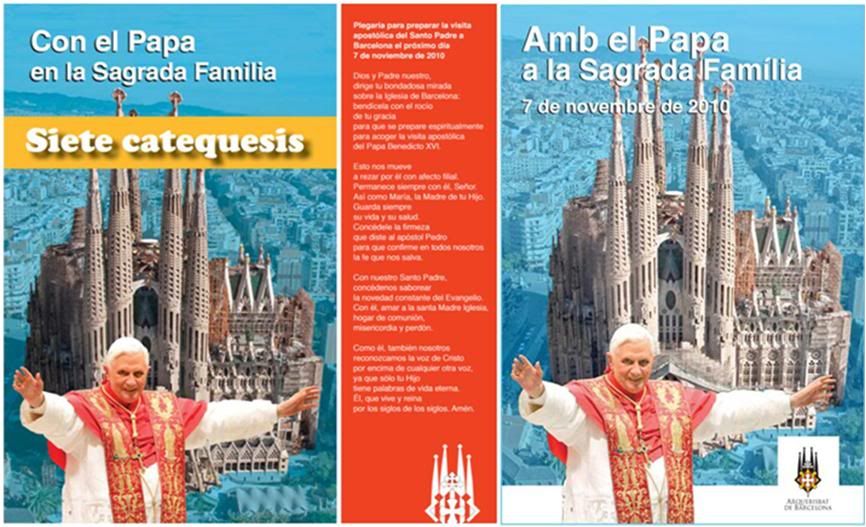
The posters, catecheses for the visit, and bookmarks carrying the preparatory prayer for the visit, have been produce3d in both Catalan and Spanish versions.
Jordi Roigé, who is in charge of communications for the visit, mentioned the launch of the website www.papabarcelona2010.org to keep the public and the media informed of all the information relevant to the Pope's visit.
Answering questions, Cardinal Martinez said that the liturgy would be in Catalan, Spanish and Latin. he said the Pope "is aware of our situation" [Catalonia is an autonomous region of Spain, and Catalans, like the Basques, are extremely proud of their language and culture as distinct from the Castilian language and culture of the rest of Spain] and expressed the hope that he would address the faithful in Catalan "as Cardinal Bertone did when he visited recently."
The Sagrada Familia has a seating capacity of 9,000 but for security reasons, admission to the papal Mass will be limited to 7,500.
However, the surrounding streets and squares - the Plaza de la Sagrada Familia and Plaza Gaudi - will be able to accommodate tens of thousands.
The cardinal said that in all, he expects at least half a million faithful to be present for the consecration and to see the Holy Father as he travels by Popemobile through the city streets during his brief visit.
The archdiocese will suspend all morning Masses on November 7 in order to allow priests to concelebrate the consecration Mass with the Holy Father and focus the attention of the faithful on the event in Sagrada Familia.
Asked about the costs of the visit, the cardinal replied: "A visit like this obviously requires some expense, and the Pope is also a visiting head of state, so some of the cost will be born by the government. Nonetheless, the Church in Barcelona is very much aware of the current economic and social crisis, therefore we have organized this visit from the point of view of austerity and cost awareness. We will do what needs to be done but do so with austerity".
The cardinal's final message:
"The Holy Father understands the catechetical conception that Gaudi intended in his church design and shares the architect's vision of the temple as a place of worship where the faithful can dedicate themselves to prayer and meditating on the Word of God.
"For this reason, we want the Sagrada Familia - while retaining its cultural and touristic value [it has been visited by four million persons yearly, Barcelona's leading tourist attraction] - will become, right after its dedication, a place of worship and celebration of the faith".
He expressed the hope that "with the continuing support and contribution of everyone, we can see the completion of the entire church complex in 2026, centenary of Gaudi's death, at which we hope we shall also be able to celebrate the beatification of this mystic and architectural genius". [The diocesan part of the process for Gaudi's beatifcation has been completed and forwarded to the Congregation for the Cuases of Sainthood, where investigation of Gaudi's life and writings is underway.]
Here is the anticipated program for the Holy Father's visit to Barcelona:
 Saturday, Nov. 6
Saturday, Nov. 6
21:00 Arrival at El Prat airport from Santiago de Compostela
21:45 Arrival at the Archbishop's Palace, where the pope will spend the night.
Sunday, Nov. 7
09:15 Travel by Popemobile to the Templo Expiqatorio de la Sagrada Familia
10:00 Holy Mass and dedication rites at Sagrada Familia.
- Before the Mass, the Archbishop of Barcelona will formally greet the Holy Father.
12:00 The Holy Father will lead the Angelus from the church's Facade of the Nativity
13:00 Lunch at the Archbishop's Palace with the archdiocesan staff and the papal delegation
17:15 Visit to the Instituto Nino Dios
18:30 Official farewell ceremony at El Prat airport
19:15 Depart for Rome
20:55 Arrival at Rome's Ciampino airport.
[Modificato da TERESA BENEDETTA 26/07/2010 18:25] |
| |
 25/07/2010 16:19 25/07/2010 16:19 |
|
| | | OFFLINE | | Post: 20.664
Post: 3.302 | Registrato il: 28/08/2005
Registrato il: 20/01/2009 | Administratore | Utente Master | |
|
 July 25, 17th Sunday in Ordinary Time
July 25, 17th Sunday in Ordinary Time
 St. James is one of the most depicted ammong the Twelve Apostles, next only to Peter and Andrew. Extreme left, St James by Rembrandt; fourth from left, by Andrea del Sarto; next three photos, James as Santiago Matamoros and as patron of pilgrims; the two on the right, St James, by Alonso Cano and El Greco.
ST. JAMES THE GREATER (SANTIAGO EL MAYOR), Apostle and Martyr, Patron Saint of Spain
St. James is one of the most depicted ammong the Twelve Apostles, next only to Peter and Andrew. Extreme left, St James by Rembrandt; fourth from left, by Andrea del Sarto; next three photos, James as Santiago Matamoros and as patron of pilgrims; the two on the right, St James, by Alonso Cano and El Greco.
ST. JAMES THE GREATER (SANTIAGO EL MAYOR), Apostle and Martyr, Patron Saint of Spain
Benedict XVI dedicated his catechesis on June 21, 2006 to this saint,
www.vatican.va/holy_father/benedict_xvi/audiences/2006/documents/hf_ben-xvi_aud_20060621...
mentioned in the Bible as third in seniority among the apostles after the brothers Simon Peter and Andrew. Indeed, he and his younger brother John (the Beloved, also thought to be the Evangelist John) were disciples of John the Baptist, and were the second pair of fishermen brothers called by Jesus to join him. James became the first of the Apostles to be martyred, beheaded by order of Herod Agrippa in 44 AD, as cited in the Acts. Before that, legend has it that he had gone to Iberia to preach the Gospel, where Mary appeared to him atop a pillar (now conserved in the Cathedral of Zaragoza, main shrine of Nuestra Senora del Pilar), and that he subsequently returned to Judea where he met his death. Subsequently, one version has his body miraculously transported by angels to Iberia where it was enclosed by a rock in Compostela; alternatively, that disciples carried the body by boat to Spain, landed on the coast of Galicia and took it inland to Compostela. The next Spanish legend concerning James (Jacobus in Latin, Iago in Spanish, hence Sant'Iago=Santiago) was that he appeared on horseback in the 10th-century battle of Clavijo to lead a vastly outnumbered Spanish army to defeat the Moors. Since then, he became known as Santiago Matamoros (killer of Moors), giving rise also to what has become the traditional battle cry of Spanish armed forces, "Santiago y cierra Espana!" (St James, and close ranks for Spain). The saint's relics were discovered in Compostela in 814 by a hermit, thus starting the tradition of the pilgrimage to the Galician town which was the third major pilgrimage destination in the Middle Ages, after Jerusalem and Rome. In Europe the routes to Compostela passing through France and Spain are known as the Camino de Santiago. The present Cathedral of St. James in Compostela was begun in 1075. In 1884, Leo XIII issued a papal bull declaring the authenticity of the relics in Compostela. [A rival claim to be the burial place of St. James is made by the Cathedral of St. Sernin in Toulouse.]
Readings for today's Mass:
www.usccb.org/nab/today.shtml
In today's OR, there is an inside-page interview with the diocesan coordinator of the Pope's visit to Santiago de Compostela on November 6, as well as the text of the Pope's letter designating Cardinal Marc Ouellet as his personal legate to the fourth centenary celebration of the baptism of the Migmaq Indian chief in Nova Scotia, Canada. Page 1 international news: North Korea threatens to use a nuclear bomb to protest US-South Korea military exercises which have been held yearly for decades; 70,000 more flee wartorn North Kivu province in the Democratic Congo; and India launches 25-euro PC to make information technology widely available in the world's second most populous nation.
THE POPE'S DAY
Angelus at Castel Gandolfo - The Holy Father spoke on the Lord's Prayer narrated in today's Gospel
and makes reference to Abraham's prayer to God invoking him to save the just in the city of Sodom -
it could be his reference to the Panorama article on gay priests apparently employed in the Roman Curia
who pursue the homosexual lifestyle outside work hours. He also greeted the Spanish people who celebrate
today the Feast of St. James, and expressed his condolences for the nightclub deaths in Duisburg, Germany.
[Modificato da TERESA BENEDETTA 27/07/2010 00:19] |
| |
 25/07/2010 17:32 25/07/2010 17:32 |
|
| | | OFFLINE | | Post: 20.665
Post: 3.303 | Registrato il: 28/08/2005
Registrato il: 20/01/2009 | Administratore | Utente Master | |
|
 ANGELUS TODAY
ANGELUS TODAY
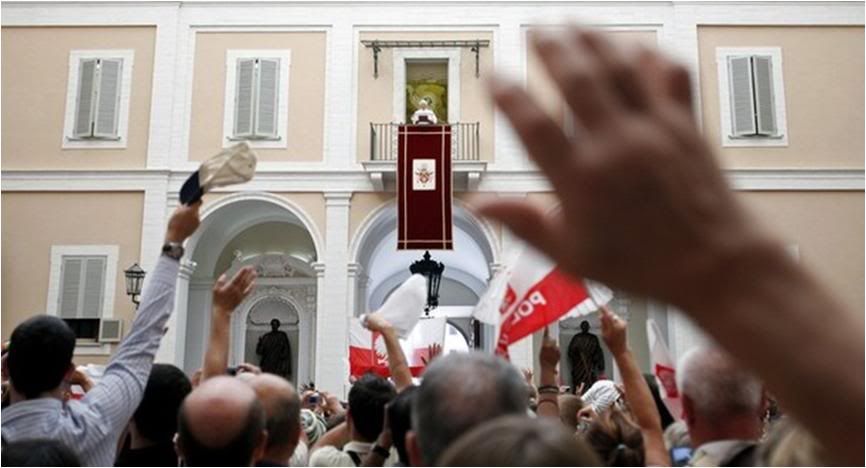
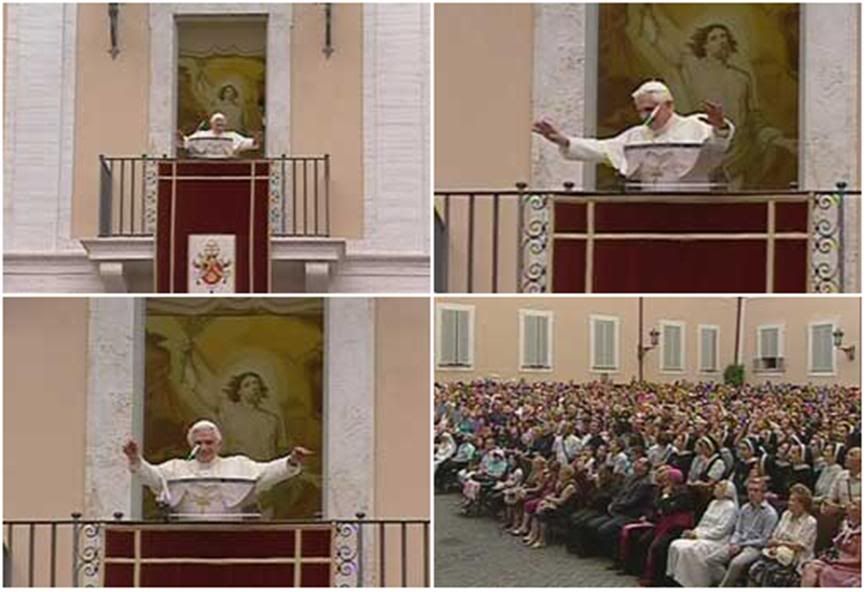
The Holy Father led the Angelus today from the window overlooking the inner courtyard of the Apostolic Palace in Castel Gandolfo.
He spoke on the Lord's Prayer narrated in today's Gospel and made reference to Abraham's prayer to God invoking him to save the just in the city of Sodom. (It could be his reference to the Panorama article on gay priests apparently employed in the Roman Curia who pursue the homosexual lifestyle outside work hours).
He also greeted the Spanish people who celebrate today the Feast of St. James, Patron of Spain, and expressed his condolences for the deaths from a stampede during a music festival this weekend in Duisburg, Germany.@
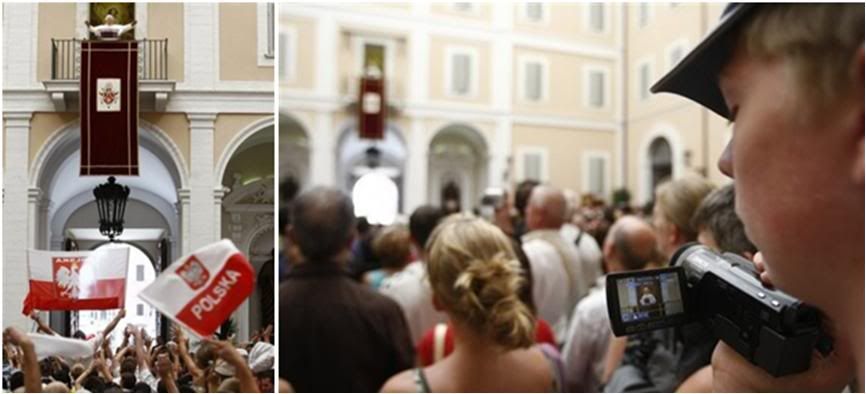
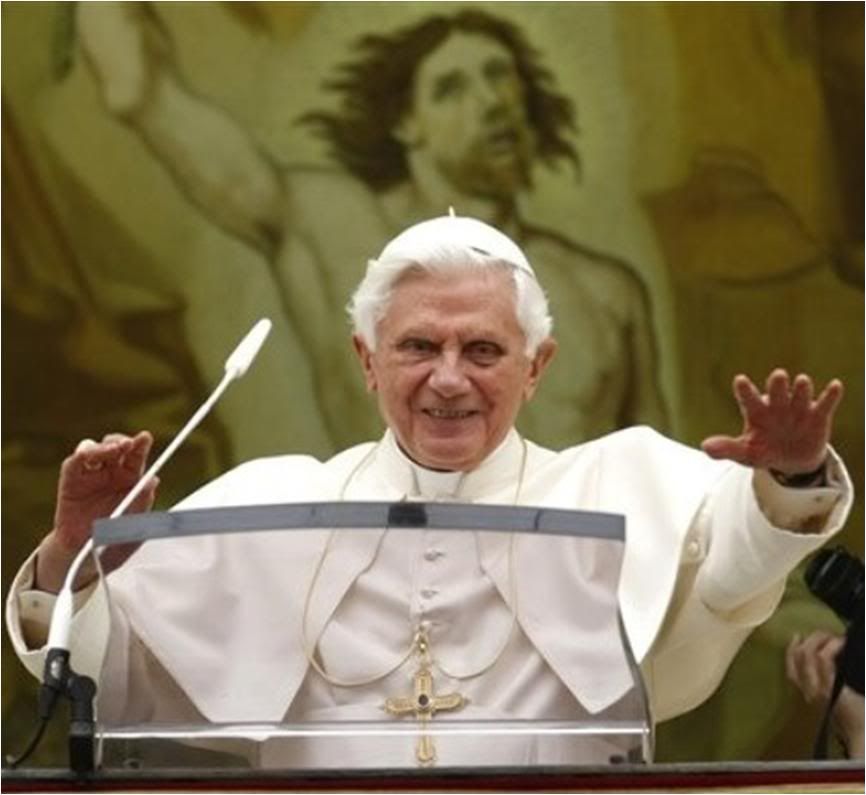

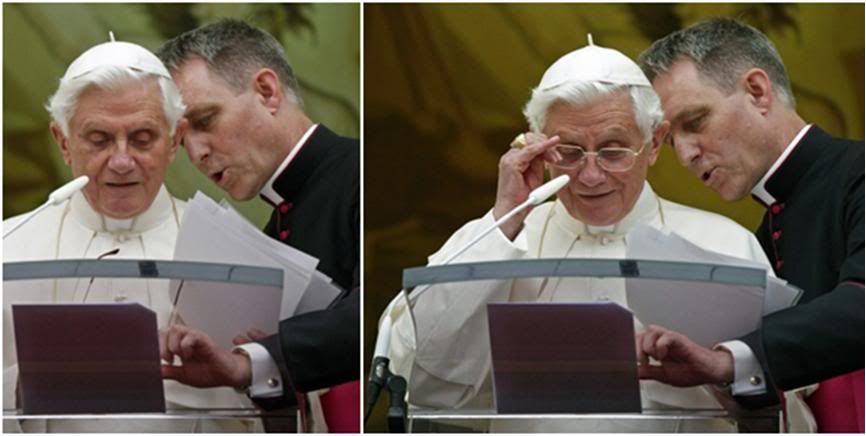 Here is a translation of the Holy Father's words today:
Here is a translation of the Holy Father's words today:
Dear brothers and sisters:
The Gospel this Sunday presents Jesus deep in prayer, a bit apart from his disciples. When he finishes, one of them says: "Lord. teach us to pray!" (Lk 11,1).
Jesus did not make any objections, he did not speak of strange or esoteric formulas, but with great simplicity, he said: "When you pray, say "Our Father"..." and taught them the Lord's Prayer (cfr Lk 11,2-4), from the prayer with which he himself addressed God, his Father.
St. Luke transmits the Lord's Prayer to us in a shorter form than that found in the Gospel of St. Matthew which has become the common usage. Here we face the first words of Sacred Scripture that we have all learned as children.
These words are impressed in our memory, they shape our life, they accompany us to our last breath. They reveal that "We are not ready-made children of God from the start, but we are meant o become so increasingly by growing more and more deeply in communion with Jesus. Our sonship turns out to be identical with following Christ" (Benedict XVI, Jesus of Nazareth, Ignatius Press, 2007, p. 138).
This prayer gathers together and expresses all human material and spiritual needs: "Give us this day our daily bread and forgive us our sins" (Lk 11,3-4).
And precisely because of the needs and difficulties of everyday, Jesus exhorts forcefully: "And I tell you, ask and you will receive; seek and you will find; knock and the door will be opened to you. For everyone who asks, receives; and the one who seeks, finds; and to the one who knocks, the door will be opened" (Lk 11.9-10).
It is not asking God to satisfy our own wishes, but rather to uphold our friendship with God who, the Gospel tells us, "will give the holy Spirit to those who ask him" (Lk, 11,13).
This was experienced by the ancient 'desert fathers' and the contemplatives of all times, who became, through prayer, friends of God.
Like Abraham, who implored the Lord to save the few just men from the extermination of the city of Sodom (cfr Gen 18,23-32).
St. Teresa of Avila invited her sisters thus: "We must always ask God to free us from every danger and to take away all evil. However imperfect our desire may be, let us strive to insist on this request. What does it cost us to ask much since we are addressing the Omnipotent?" (Cammino, 60 (34), 4, in Opere complete, Milano 1998, p. 846).
Every time that we say the Lord's prayer, our voice intertwines with that of the Church, because whoever prays is never alone.
"Every faithful Christian must strive to be able to find - in the truth and richness of Christian prayer taught by the Church - his own way, his own manner of praying.... thus allowing himself to be led by the Holy Spirit, who will lead him through Christ to the Father" (Congregation for the Doctrine of the Faith, 'Some aspects of Christian meditation', Oct, 15, 1989, 29:AAS 82 (1990), 378).
Today is the Feast of the Apostle James called the Greater, who left his father and his occupation as a fisherman to follow Jesus, and gave his life for him, the first to do so among the Apostles.
From my heart, I address a special thought to the pilgrims who have flocked to Santiago de Compostela for this feast! May the Virgin Mary help us to rediscover the beauty and profundity of Christian prayer.
In English, he said:
I am pleased to greet all the English-speaking pilgrims here present!
In today’s Gospel Jesus teaches us the Lord’s Prayer. Following Christ’s own example, I encourage you to pray for the grace always to be worthy sons and daughters of our Father in heaven, and loving brothers and sisters to each other.
May God grant you his abundant blessings!
In German, he added some words about last night's tragedy in Duisburg:
Today, I particularly entrust to our merciful Father in heaven the young people who lost their lives tragically in Duisburg yesterday. I ask the Holy Spirit to grant comfort and support to their sorrowing families and friends as well as to the injured. May God bless you all.
In Spanish, he said:
I affectionately greet the Spanish-speaking pilgrims here. Dear brothers and sisters, the Gospel today invites us to be constant in prayer, addressing God with the prayer that Jesus taught us and that the apostles transmitted to us.
On this Sunday we also celebrate the Feast of the Apostle St. James, who has been venerated since time immemorial in Compostela, and whose cult is deeply rooted in your countries (Hispanic).
On this Holy Year in Compostela, I too expect to join the numerous pilgrims when I visit in November, during a trip when I will also visit Barcelona.
Following the steps of St. James, let us pursue the path of our life, giving constant witness of faith, hope and charity.
And in Italian again:
Finally, today is the 'Sagra della pesche' [Peach Festival] in Castel Gandolfo. Let us thank God for the fruits of the earth and of human labor! Best wishes to the administration and the citizenry, and a good Sunday to everyone!
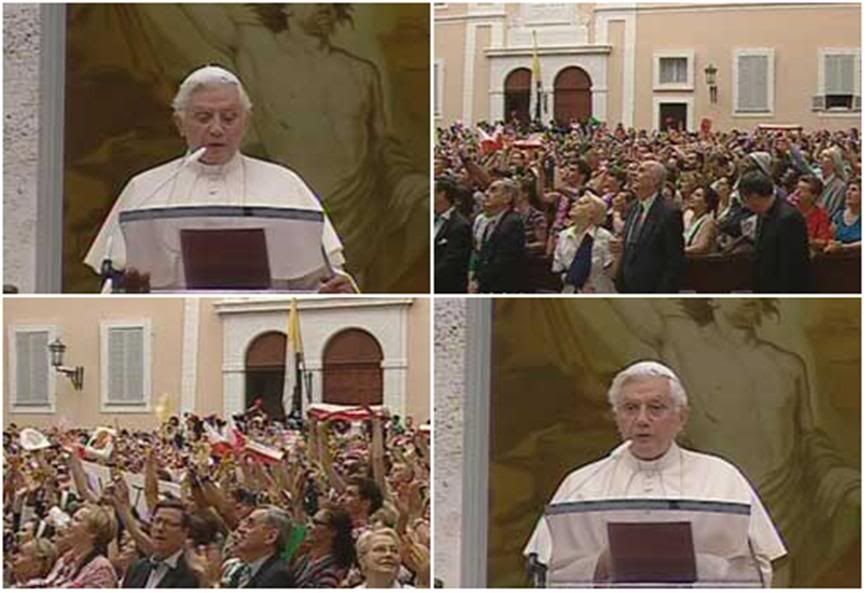
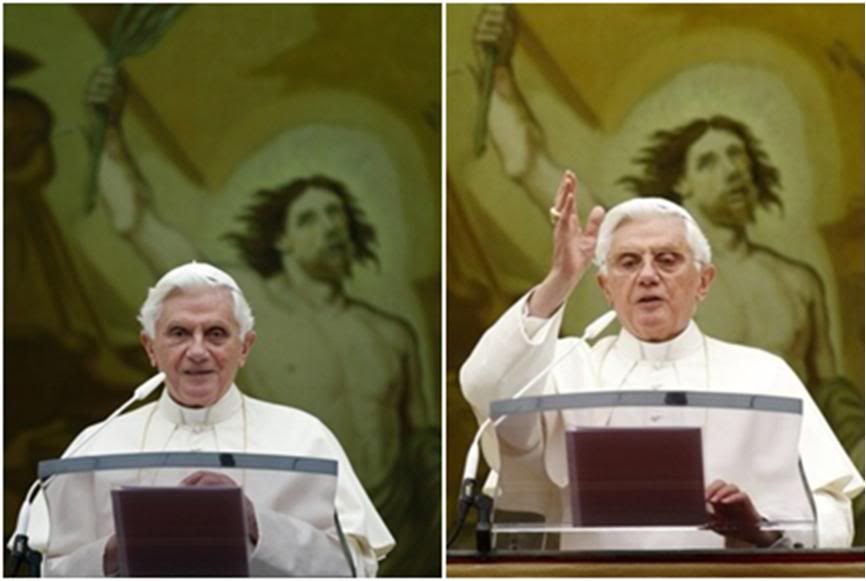
* About the Duisburg tragedy:
Nineteen people died as a result of a “stampede” at a musical festival called the “Love Parade” in Duisburg, Germany on Saturday night. According to Reuters, after closing the only entrance to the festival, a tunnel, in an attempt to better organize the massive crowd, “mass panic” broke out.
The techno dance festival drew an estimated 1.4 million young people from all over Europe. It was originally an event to promote peace, with the first parade taking place in the German capital city just months before the fall of the Berlin Wall.
Reuters reported that police have opened an investigation to determine the cause of the panic that led to the fatal stampede which also injured more than 300 people.
[Modificato da TERESA BENEDETTA 26/07/2010 11:00] |
| |
 25/07/2010 19:31 25/07/2010 19:31 |
|
| | | OFFLINE | | Post: 20.666
Post: 3.304 | Registrato il: 28/08/2005
Registrato il: 20/01/2009 | Administratore | Utente Master | |
|

 Awaiting Benedict XVI's visit,
Awaiting Benedict XVI's visit,
Compostela celebrates
the feast day of St. James
by Marta Lago
Translated from
the 7/25/10 issue of

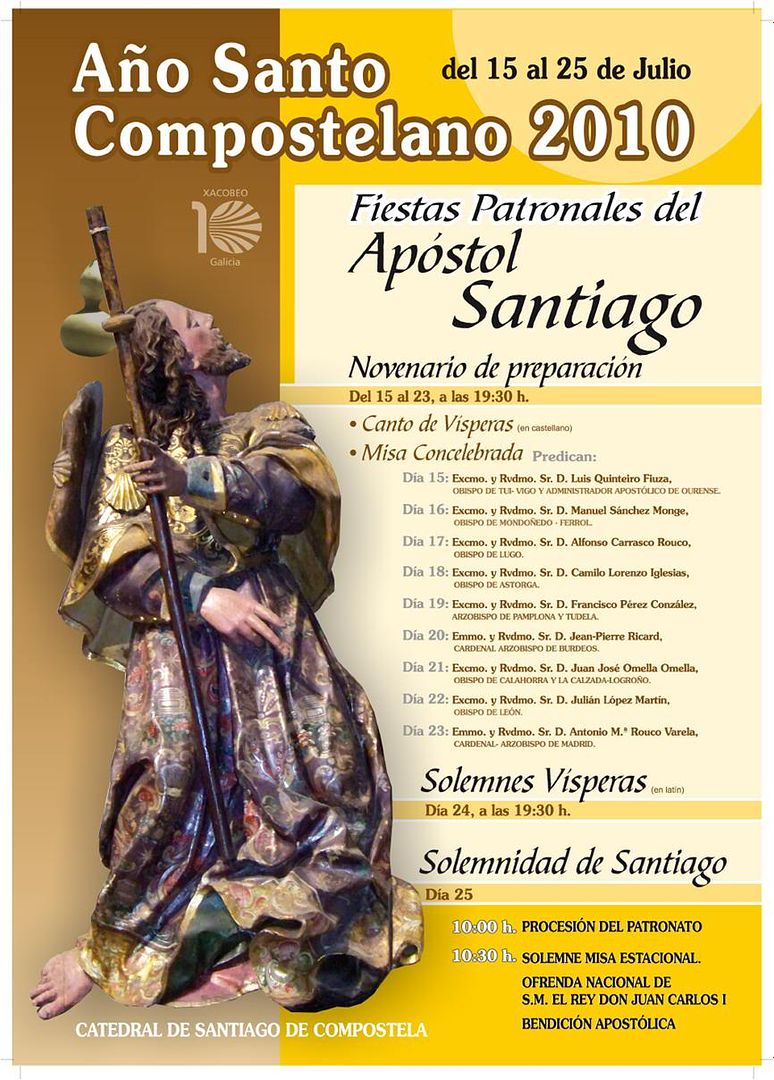
The millennial embrace of the Apostle James culminates today, July 25 - feast day of Spain's patron saint - in Galicia, northwest Spain, medieval fulcrum of evangelization for Europe and the world.
An embrace that already extends to Benedict XVI three months before his visit to Santiago de Compostela, the first visit expressly made by a Pope to venerate the saint on a Jubilee year.
Diocesan general coordinator for the Pope's apostolic visit on November 7, Mons. Salvador Domato Bua, spoke to us about the visit:
Compostela's celebration of St. James this year is remarkable both because it is a Holy Year but also because of the Pope's visit. Is this a time of spiritual renewal?
As you know, a Jubilee Year is celebrated every time that the saint's feast day falls on a Sunday, therefore, it is not a fixed observance. The next one will not come until 2021.
Traditionally, the 'Ano Santo Jacobeo' (Holy Year of St. James) was called the year of 'great pardon', even if the term is less used today. The term underscores the aspect of the observance as a close personal encounter with God as well as its penitential aspect.
One of the most obvious signs this year is the increase in the number of people going to Confession. The cathedral's chapter canons have been making sure that there are enough confessors present for longer periods in the Cathedral, who can hear confessions in different languages, and also who can give more time to each confessant.
In addition, it is always surprising to hear from the pilgrims - who these days have been streaming in like a river in flood - that what they feel on making the pilgrimage, especially those who arrive by the traditional pilgrim routes, is that they are first able to meet themselves, who they really are. And this helps them to go on and seek an encounter with the Lord in the sacraments.
The prelude to the big day today was a novena of Masses, in which each day's Mass was entrusted to a visiting bishop.
In the diocese, we have recently revived the practice of celebrating Solemn Vespers. They are very beautiful in both content and form. They are Vespers honoring the Apostle, using Biblical texts that are carefully chosen and edited. We have the participation of the cathedral choir and of an orchestra; Gregorian chant is used, the canons wear mantles from the 16th century which were given by the first Queen Isabella. Everything underscores the solemnity of the feast.
The procession of the Patronate of St. James will take place before the Mass today. The image will be borne out from the Fachada de las Platerias and re-enter the Cathedral through the main entrance facing Plaza Obradoiro.
During the Mass, the King of Spain will lead the National Offering and Prayer. Other unusual features of the Mass is the use of the Cathedral's giant swinging censer [Botafumeiro] and of chirimias, medieval instruments [the direct antecedent of the oboe] that are well conserved at the Cathedral.
What is the National Offering and what does it mean?
It is a practice that was instituted five centuries ago. It expresses the gratitude of the Spanish people to St. James for the protection that he has always given us, to the homeland, to the sons of Spain, from the time of the Reconquest. In the old days, it usually came with an offering of money, an artistic work or a special commemorative item for the Cathedral. Not anymore. The King - or his representative - leads an invocation to St. James.
The festivities of July 25, in effect, provide a sort of dress rehearsal for the Pope's visit...
Yes. Then there will be another test: the pilgrimage and meeting of young people (PEJ 2010) on August 5-6, when up to 15,000 young people will gather in Compostela.
And how are the young people preparing for the papal visit?
Right now, under the guidance of the diocesan officials for the pastoral care of young people, they are focused on PEJ. Our young people are aware that we need their participation, even in the papal visit.
The youth are our priority. Compostela has been a reference point for the Catholic youth of Spain and Europe since the World Youth Day was held here in 1989. Even today, after 20 years, I am always touched when, in my travels to other parts of the world, I meet persons who tell me, "I was in Compostela for World Youth Day". Even better is meeting so many priests and religious who say that being here for WYD was the final event that made them decide to consecrate their lives to the Lord.
When Benedict XVI visits on November 6, he will proceed directly to the Cathedral, pray before the tomb of St. James, cross the Holy Year Door, give the traditional embrace to an image of the saint, meet with sick persons, older people and children, and then preside at Mass in Plaza Obradoiro. He will be a pilgrim among pilgrims...
In fact, we do not refer to it simply as a trip, but as a pilgrimage. The motto we have chosen for the visit is: "Pilgrim of faith, witness to the Risen Christ".
We think it captures the sense of the Pope's pilgrimage, and what he has written, thought, and preached about Europe and its Christian roots. It brings back the famous saying that "Europe took shape in the pilgrimages to Compostela".
In fact, we are very honored that European unity took shape, in effect, along the 'Camino de Santiago' - the way of St. James - and we certainly do not wish this to be overlooked.
We are preparing for the Pope's pilgrimage very aware that, although it will only last a few hours, his presence among us will give Catholics and all persons of good will, the certainty of faith, the constancy of hope, and the courage of charity. And we expect that it will leave a very deep mark.
It will be the third papal visit to Compostela, and so our people are confident about our ability to host such an event. At the same time, one can never get used enough to close contact with the Supreme Pontiff and to the impact of his presence on Christian life among our people.
You said that the coming visit is already proving to be quite fecund. In what sense?
It's the third papal visit I have had to coordinate for the diocese. And I have the impression that public anticipation has never been greater than for this visit. In 1982, John Paul II's first visit here was an absolute novelty. The second time he came was for World Youth Day. This time, a particular joy is perceptible - as if the people need a shot of optimism and hope and they believe that they will get this from the Pope. That is my impression.
Do you anticipate any particular difficulties in the program for the Pope's visit?
Certainly, because there are always logistical problems in having a Papal Mass held in a limited space like Plaza Obradoiro. But with good will and the cooperation of the faithful, we will try to satisfy everyone. We will clear nearby areas to accommodate more Massgoers, we will set up jumbo screens, we will plan the Pope's routes so that the maximum number of people can see him. To see him in this manner is an experience that we hope to make possible for many.
Organizationally, how is the work going?
With great commitment and industry! And precisely because we do want to maximize the exposure of the Pope to the faithful. But we have to reconcile this with security considerations. As for details, I can tell you that we have already ordered 500 ciboria for the distribution of Communion at the Pope's Mass. They are enamelled vessels produced by a Galician firm.
The Pope will embrace the Apostle James and Compostela will embrace the Pope...
It will certainly be an embrace of affection, of gratitude, of joy, hope and love.
What gifts will the Archdiocese give the Pope?
We have expert goldsmiths already at work. Goldsmithery has a long and distinguished tradition in Compostela. We will also donate a sum for the Pope's charities. And of course, there will be a commemorative medallion of teh visit.
The Feast of St. James takes place a few days after the second annual meeting of the French and Spanish bishops whose dioceses are found along the 'Camino de Santiago'.
Yes. this was an initiative of our Archbishop, Mons. Julián Barrio Barrio, who almost daily, celebrates Mass for pilgrims in the Cathedral.
The meetings among the Spanish and French bishops have been an occasion fro them to reflect together on the Pope's project for the re-evangelization of Europe, which urgently needs it. It is very important because in the past, the 'Camino de Santiago' was a formidable way to evangelize Europe.
 Spanish monarchs come to Compostela
Spanish monarchs come to Compostela
to renew 'National Offering' and prayer
on the feast of St. James
Adapted and translated from
various Spanish news sources;
Photos from

July 25, 2010
 Left, King Juan Carlos delivers the Ofrenda Nacional; below eight, the giant censer (botafumeiro) in action.
Left, King Juan Carlos delivers the Ofrenda Nacional; below eight, the giant censer (botafumeiro) in action.
SANTIAGO DE COMPOSTELA - Spain's Jubilee Year of St. James culminated today in a Mass at the Cathedral of Compostela, where King Juan Carlos I led the traditional 'Ofrenda Nacional (National Offering) of the Kingdom of Spain to its patron saint.
In it, he also asked the Apostle, in the name of the Spanish people, to intercede for the unity of all Spaniards, including the autonomous regions, for help in resolving the serious economic crisis and its harsh consequences for millions of families and individuals, especially the young, and to eradicate the 'unreason of barbaric terrorists'.
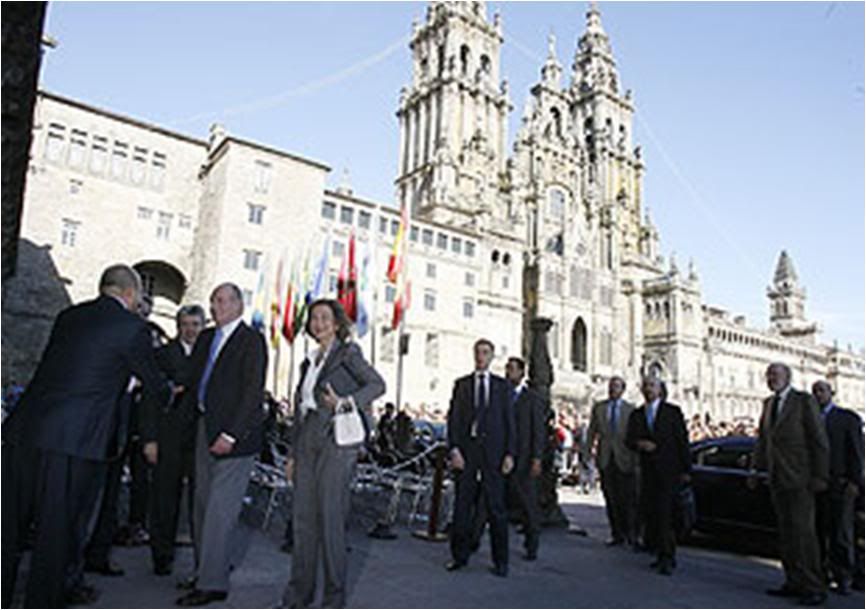 Monarchs arrive in Compostela on the eve of the feast; below, they are welcomed by Archbishop Barrios today for the Mass.
Monarchs arrive in Compostela on the eve of the feast; below, they are welcomed by Archbishop Barrios today for the Mass.

The King and his wife, Queen Sophia, arrived in Compostela last night before sundown, and what the news reports today describe as the most magnificent fireworks yet presented on Spain's religious national day.
The royal couple is expected to return to Compostela in November to welcome Pope Benedict XVI when he visits the tomb of St. James as a pilgrim during this Jubilee Year. Along with the monarchs of Belgium and Luxembourg, the Spanish Kind and Queen are the only reigning Catholic monarchs today.
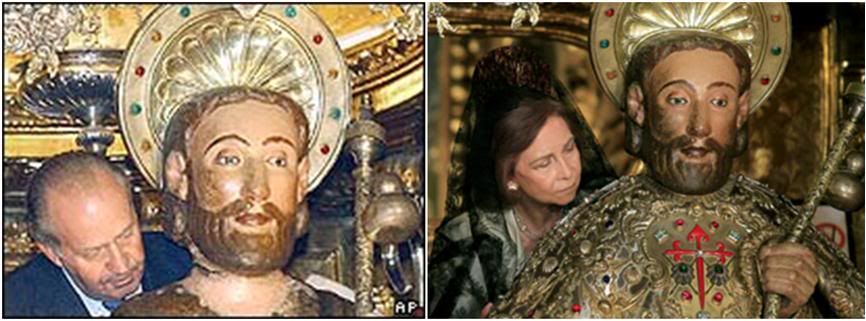 The monarchs perform the traditional 'abrazo' (embrace) of the Apostle.
The monarchs perform the traditional 'abrazo' (embrace) of the Apostle.
The King and Queen previously attended the Jacobean Jubilee Years in 1989 and 2004. The next Jubilee Year will be in 2021.
The fireworks were preceded by a state-of-the-art son et lumiere presentation projected on the front facade of the Cathedral. A crowd of 100,000 was on hand.
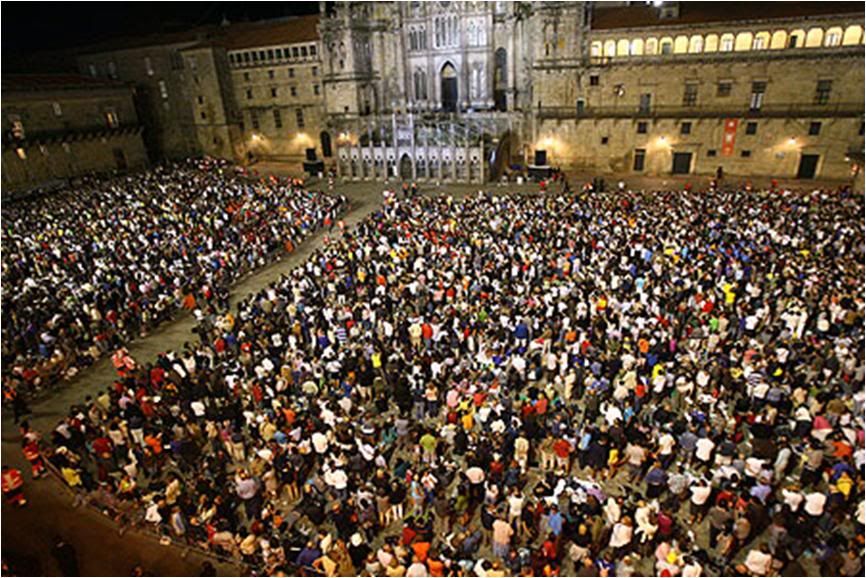
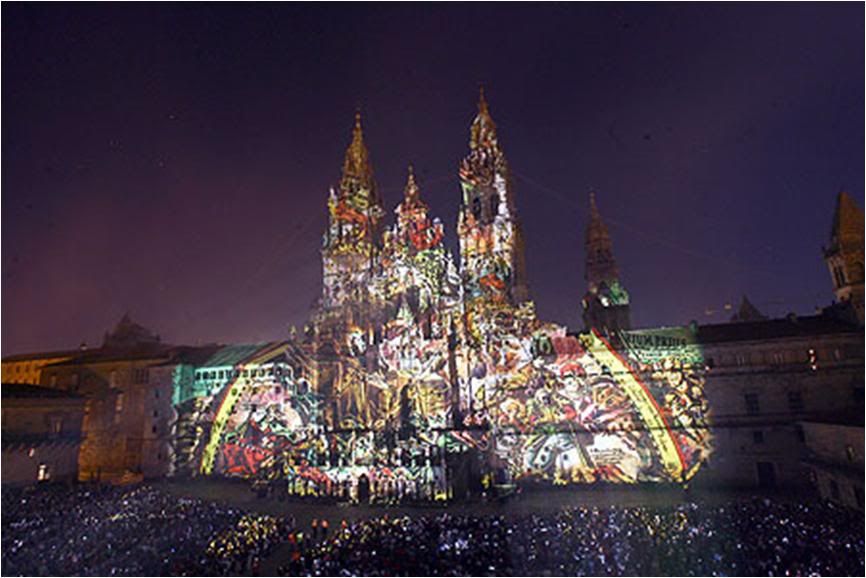
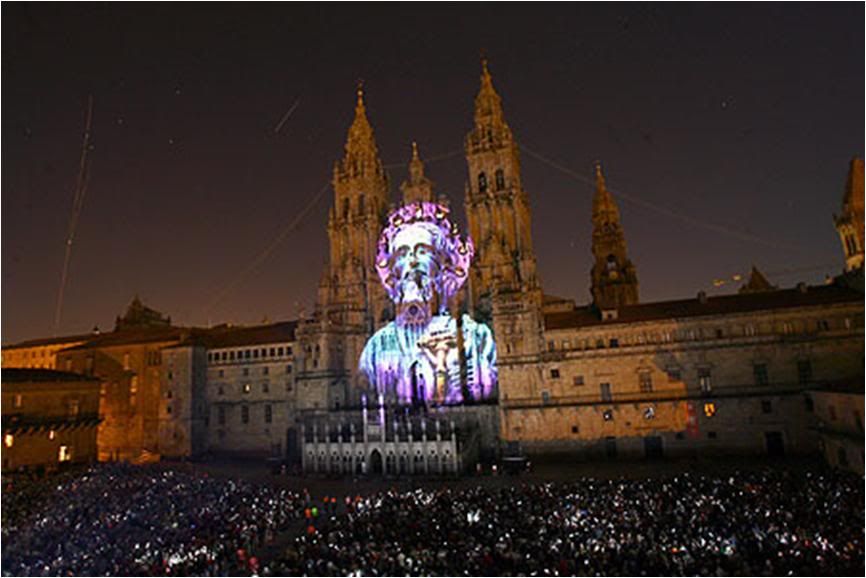
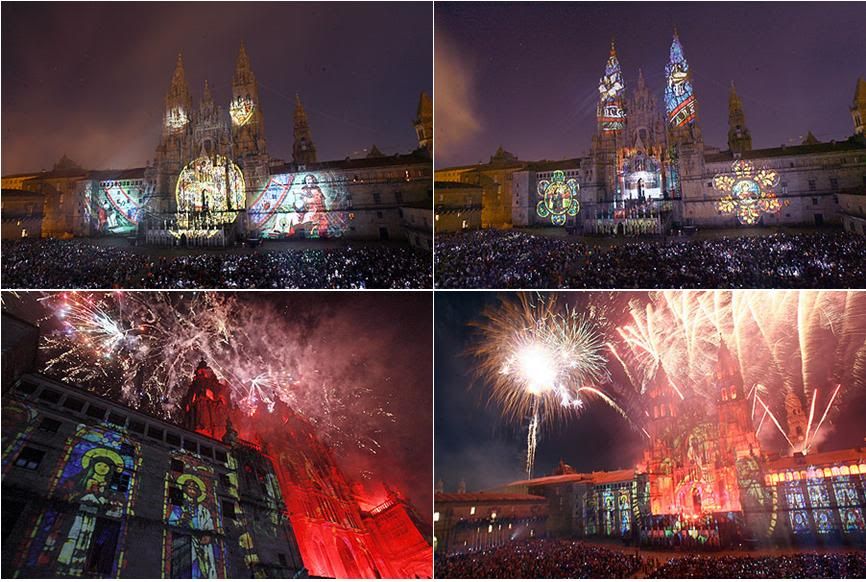

 Pilgrims flock to Compostela
Pilgrims flock to Compostela
via the Way of St.James
during Holy Year
by ELISA SANTAFE

SANTIAGO DE COMPOSTELA, July 25 (AFP) - They come from around the world to have time to think, fulfil a promise or have an adventure: the gruelling "Camino de Santiago" has seen an influx of pilgrims this year, a Holy Year, for a variety of reasons.
Joshua Fleming, a 20-year-old Austrian student, said he decided to make the pilgrimage to Santiago de Compostela in northwest Spain after reading best-selling Brazilian author Paulo Coelho's book describing his own pilgrimage in 1986.
"The challenge has opened my spirit," he said at the town of Pedrouzo at the start of the last leg of his pilgrimage, after having already walked some 300 kilometres (185 miles) across northern Spain.
The complete "Camino de Santiago" or "Way of St.James" pilgrimage route usually begins in the Pyrenees mountain range on the Spanish-French border and ends some 800 kilometres further west at Santiago's cathedral which the faithful believe holds the remains of St. James, one of Jesus's 12 Apostles.
The cathedral, which in the Middle Ages was considered the third most holy place in the Roman Catholic world after Jerusalem and Rome, has been a magnet for pilgrims for centuries.
But their numbers soar whenever July 25, the name day of St.James, falls on a Sunday as it does this year.
Last month alone over 33,000 pilgrims flocked to Santiago, compared to just under 20,000 during the same month last year, according to the archdiocese of Santiago de Compostela.
It estimates the number of pilgrims arriving in the city this year will be similar to the last Holy Year in 2004 when 180,000 people made the journey. The next Holy Year falls in 2021.
Visitors this year will include Pope Benedict XVI who is scheduled to stop over in the city during a visit to Spain in early November. [It is not a stopover - he is visiting Compostela expressly to make a pilgrimage to the tomb of St. James.]
Claude Champagnon, 64, and her daughter Karine, 44, from Puy-en-Velay in central France, walked the "Camino" in 2003 and are repeating it this year because it is Holy Year, when those who make the pilgrimage believe they are granted remission for their sins.
But they are unhappy to face competition for beds at the budget hostels along the route from those "who are on the 'Camino' without religious reasons".
That is the case of Jorge, Nicolas and Nacho, three 18-year-olds from Madrid, who admit they are walking part of the "Camino" to "have fun and party" by stopping in at bars and nightclubs en route.
Just over half, 55 percent, of the pilgrims who arrived in Santiago last month said they made the trip for religious reasons, five percent said they did it for cultural reasons and the rest said they were motivated by both, according to the archdiocese of Santiago.
"We prepared our trip without knowing that it was a Holy Year, but that makes it even more special," said Sonja Hahn, a 42--year-old from Germany as she waited in line for a bed at a hostel at Pedrouzo.
Her partner Klaus Becker, 56, does not share her religous motivations but is nonetheless carrying a picture of a friend who died two weeks ago in his backpack.
"It is like she is coming with me," he said.
Many who make the journey still wear the traditional garb of cape, long staff and carling felt cap adorned with scallop shells, the symbol of the saint which can be found all over the city.
In the Middle Ages pilgrims used to burn their worn out clothes after ending their journey at Cape Finistere, about 100 kilometres west of Santiago, which was then considered to be the end of the world ['finis terrae' - a cape in Galicia is in fact called 'Finisterra'.]
Some still keep up this tradition. Cesar Machado, a 46-year-old diver from Lisbon, said he was picking up plants along the way which he plans to burn along with his clothes when he finishes his pilgrimage by bicycle.
"It is the philosophy of being reborn from the ashes," he said, adding he was carrying candles from friends who are ill to light at Santiago's cathedral.
"I am fulfilling a promise that I made four years ago, it is a spiritual issue and also a search for adventure."
Pilgrims who have travelled at least 100 kilometres on foot or 200 kilometres by bicycle or on horseback can obtain the "compostela", the Latin certificate confirming they have completed a pilgrimage to the cathedral, as long as they collect stamps from hostels or churches along the way as proof.
Yoonjung Jang, a 27-year-old statistics student from South Korea, said she decided to walk the "camino" after breaking up with her boyfriend in order to "forget everything".
"Nothing has changed, but it is a very good experience", she said.
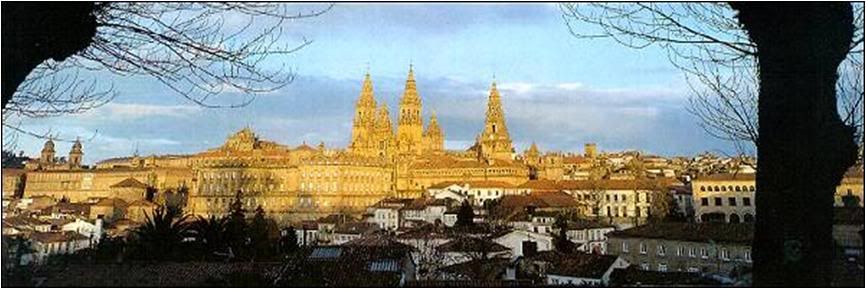
[Modificato da TERESA BENEDETTA 29/07/2010 20:08] |
| |
 25/07/2010 23:44 25/07/2010 23:44 |
|
| | | OFFLINE | | Post: 20.667
Post: 3.305 | Registrato il: 28/08/2005
Registrato il: 20/01/2009 | Administratore | Utente Master | |
|

 Not unexpectedly, L'Osservatore Romano has been silent so far on the Panorama reportage on the gay nights of three gay priests in Rome - not even an item on the prompt reaction from the Vicariate of Rome, which is after all, the diocese of the Bishop of Rome, the publisher of the Vatican newspaper himself. Who, by the way, did not miss the occasion to slip in a line about Abraham imploring God in behalf of the just men of Sodom in his Angelus homily today.
Not unexpectedly, L'Osservatore Romano has been silent so far on the Panorama reportage on the gay nights of three gay priests in Rome - not even an item on the prompt reaction from the Vicariate of Rome, which is after all, the diocese of the Bishop of Rome, the publisher of the Vatican newspaper himself. Who, by the way, did not miss the occasion to slip in a line about Abraham imploring God in behalf of the just men of Sodom in his Angelus homily today.
The deliberately titillating and malicious reportage of Panorama is very much the topic in the rest of Italian media, including Avvenire, the Italian bishops' newspaper. Here is its excellent editorial today:
The scandal of a few
to cast mud on all the Church:
How to use evil to say
that no good exists!
by Marina Corradi
Translated from

July 25, 2010
In the lull of a July that has been scarce with the kind of headlines that help newspaper circulation, one of the most popular Italian newsweekly magazines has dedicated its cover story to 'nights on the town with gay priests'.
Seven pages pf a journey through the sins of three priests in the Eternal City - between gay events, clubs and saunas, and their bedrooms. In which one of them says that '98 percent of all the priests I know are homosexual'. [Which will probably be the lingering 'soundbite' out of the entire reportage!]
Photos, videotapes, punctilious identity checks, Pulitzer-Prize-chasing grit. To show what exactly? That there are, out of the many hundreds of priests who live and work in Rome, some homosexuals.
Let's assume that everything Panorama says in the article is pure gold. That some priests in Rome live a double life. Of course, it is a cause for pain and concern to the faithful.
But the so-called investigation, the smug cover picture of male hands with lacquered nails holding a rosary, what do they really tend [and intend] to show?
Even if all of it is true, what is the weight of the indignity and dishonor of such sinful priests in the face of the daily life of Rome's 336 parishes, where more than 1,300 priests - living just one life dedicated to God and their fellowmen - strive daily to be worthy priests, to say Mass, administer the Sacraments, educate the young, work with the most needy in society?
How can is the overwhelming amount of their unpublicized daily efforts be nullified by finger-wagging moralists who are capable only of seeing scandal? Scandal that is zealously served up to the reader as if to say, "Look at the Church! Everything is rotten, everything is a lie, everything is filth".
But there is an obvious abyss between this smug nihilism and reality, as those who take part in parish activities cannot fail to see. The majority of priests, in Rome and elsewhere, are something other than the three men whose stories are told in Panorama.
The majority are men who literally break their backs helping children to find some sense in life, in countless centers in the suburbs. Or missionaries who have volunteered to spend their life in places where few of us would last a day. And those who take care of the aged and those defeated by life, to bear witness to them that not everything is over.
But it is the media practice of the time to make all priests look bad. With a blind hostility that goes beyond the true or presumed sins of a few. As though to show that it is absurd for anyone to vow faithfulness that is absolute and for always to God. Because what faithfulness - or faith - is there in men who say Mass by day and indulge in profligate immorality by night?
But this moralistic finger-wagging totally ignores the greater part of reality - the good part that priests do, and which millions of believers around the world experience daily.
We must be careful of spotlights that only shine on part of reality. Because they tend - and intend - to negate the much greater good because of the sins of a few, to break down the trust of the faithful in a thousand other ways.
It is squalid, this story of priests who go from sin to saying Mass. They are pitiful. As we all are, in far less scandalous ways, perhaps - but we all lie a bit, we are all faithless at times, we can all be sly and self-indulgent.
And yet, this 'major investigation' screams: "Look at them! How can anyone believe in men like these? There is no one in the Church that deserves any trust. They claim to be ministers of God? Look what they do in their free time!"
The media are like a woodworm eating away at our faith and our hope. Using the bad example of a few to say that no good exists in the Church. And that the only 'truth' around is - nothing at all!
But look around you: at the priest who is taking your kids on an excursion in the mountains, the priests who walk the corridors of our hospitals and jails, those who say Mass daily in places all but forgotten by the world, under the most difficult conditions, but who remain obstinate witnesses to hope. The hope that is completely other than the illusions peddled and boasted about by the media.
There are two things that must be pointed out about this problem:
First, the Panorama attack is obviously an extension of the pedophile-priest scandal - something just as salacious in the absence of anything new to report on the pedophilia front.
Second, I wish the Avvenire editorial had also said something about how the Roman Curia needs to deal with the problem of homosexual priests who care so little for their vocation and for the Church that they openly indulge their lusts. Should not the Secretariat of State, which oversees the internal affairs of the Curia, take an active lead in doing this?
In the five years that I have been following Church-related news in the Italian media, this is certainly not the first time that this problem has emerged prominently in the news - and usually, the alleged culprits are priests employed in the Curia, not those working for the Diocese. Ignacio Ingrao mentioned instances where the Vatican has moved against prominent culprits in the Curia. But what is being done to discipline - i.e., dismiss or defrock - any remaining priests who persist in their sacrilegious ways?
Again, my objection to homosexual priests is not to their being homosexual at all (deviant preferences, while uncommon, do exist) but only if and when they cease to practice the discipline of their vocation and fail to overcome/suppress/resist/sublimate their carnal inclinations in the same way that their heterosexual colleagues are expected to do. They knew when they became priests that they were signing up for lifelong chastity. There is no excuse for their sacrilege when they violate that standard, and they should, as the Vicar of Rome said, leave the priesthood if they cannot be worthy of it.
In the Catholic faith,
the homosexual act is
the worst carnal sin
because it is unnatural
by Luigi Accattoli
Translated from

July 25, 2010
In Catholic morality, the homosexual act - also called sodomy and an 'unnatural act' - is worse than any other sexual offense.
The Catechism of St. Pius X listed it among the four sins "that cry out for retribution in the eyes of God", namely: voluntary homicide, unnatural acts of impurity, oppression of the poor, and defrauding laborers of their just wages.
'Crying out for retribution' means they merit divine punishhment, such as was meted to the city of Sodom which was annihilated by a rain of fire.
Dante's Biblical fantasy shows persons who sinned by sodomy fleeing a firestorm and depicts their circle in hell as many degrees far below the circle of those punished for carnal sins that are not 'unnatural'.
The note issued by the Vicariate of Rome says that the three priests reported on by Panorama "should not have become priests". That a homosexual should not be admitted to Holy Orders, and must be dismissed once discovered, has been a constant in Catholic tradition.
Pier Damiani [Doctor of the Church, 1007-1072] - one of the 'teachers' cited by Dante - famously denounced "sodomite filth that can afflict the Church like a cancer". [Damiani used the word 'immondizia' which refers to anything unclean or impure.]
Immunditia [in Latin]: When Cardinal Ratzinger referred to 'filth in the Church' in 2005, he had that old Latin word in mind.
The inadmissibility to the priesthood of candidates with homosexual tendencies was reaffirmeed in an early Vatican Instruction under Benedict XVI.
Priests who take part in heterosexual orgies obviously deserve to be sasnctioned, too, but the Church is doubly concerned about practising homosexuals - not just for the sin itself, but for the tendency to commit it.
The Catechism of the Catholic Church states in No. 2357ff that homosexuality is 'an objectively disordered tendency" that can lead to 'acts that are contrary to nature".
BTW, other than Andrea Tornielli on his blog, I have not yet seen any commentator - not even Marina Corradi in Avvenire - denounce the flagrant exploitation by the Panorama reporter of his informer to bait the priests he reported on, to the point of having sexual relations that could be recorded by a hidden camera. Nowhere in the Panorama article does the reporter even manifest that he had any second thoughts about using the informer in the way he did. Failing to denounce something so blatant a violation of journalistic ethics - and of common-sense ethics in general - is tantamount to sanctioning the action. The Italian journalists' guild should take action!
7/26/10
ADDENDUM: Orazio La Rocca of La Repubblica claims that from the site indications in the Panorama videoclips and a few other clues, he found it easy to establish the real identities of Paul, Carlo and Luca, who, he says, all work in 'important dicasteries of the Roman Curia'.
Paging Mons. Filoni (the deputy secretary of state for internal affairs), do your job and right away! Weed out all these undesirables in the Curia now. You've tolerated (or ignored their presence) too long - it's been five years. There can be no excuses for them, no matter how brilliant and gifted they may be. Have them leave the priesthood and use their talents elsewhere. They should deal with their own private demons and sins as civilians, not as priests who are supposed to be in persona Christi.
Better still, why does Cardinal Bertone not stand up for once and take an initiative for a change? As a service to the Pope and the Church, he should announce and take all measures necessary to purge the Curia of these undesirables who do not even think they are doing anything wrong! Remember what Benedict XVI said on his way to the US in April 2008? "Better fewer priests but good ones!"
[Modificato da TERESA BENEDETTA 26/07/2010 12:50] |
| |
 26/07/2010 10:55 26/07/2010 10:55 |
|
| | | OFFLINE | | Post: 20.668
Post: 3.306 | Registrato il: 28/08/2005
Registrato il: 20/01/2009 | Administratore | Utente Master | |
|

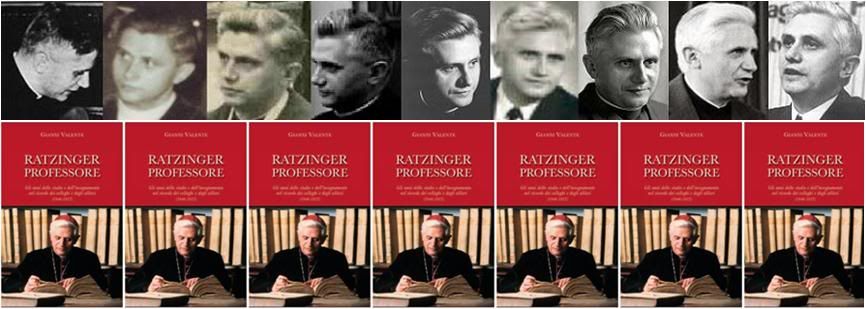 Thanks to Lella's blog
Thanks to Lella's blog

for leading me to this item.
The secret of Professor Ratzinger
by Fr. Piero Gheddo
Translated from

July 18, 2010
As summer reading, I have chosen, among others, Ratzinger professore by Gianni Valente (San Paolo 2008, 208 pp). It is a most interesting text for getting to know Joseph Ratzinger in his younger years and therefore to better understand Pope Benedict XVI today. Its subtitle is "The years of study and teaching as recalled by his students and colleagues (1946-1977)".
In a blog entry, it is impossible to synthesize the richness of this reconstruction of the youth and maturation of the man whom the Lord Jesus has chosen to be his Vicar on earth for our time. I will simply note two points that show the continuity between Joseph Ratzinger as student and priest and as Supreme Pontiff of the universal Church.
First, the lectio magistralis he gave on June 24, 1959, to start his professorship at the University of Bonn was entitled "The God of faith and the god of the philosophers".
The 'urgent question' that the 32-year-old professor confronted was the modern divorce between faith and reason, between a religion confined to the personal and private realm, intimate and sentimental, and rational search which from Kant onwards has denied the possibility of ever knowing God, much less having access to him.
Citing St. Thomas, Ratzinger said it was possible to overcome every deleterious opposition between the language of faith and that of reason. The God who manifests himself gradually in the Old and New Testaments coincides at least in part with the 'god of the philosophers", that is, the search for God that modern men undertakes. The problem is that of language.
The Fathers of the Church achieved an admirable synthesis between Biblical faith and the Hellenic spirit. In the same way, the young Ratzinger said, "If today it is essential to emphasize that the Christian message that is not a secret esoteric message for a limited circle of initiates but the message of God addressed to all men, then it is equally essential to translate it for the outside world in the common language of human reason".
But the young German professor (a priest since 1951) had no illusions. In a 1958 article, the 31-year-old Ratzinger wrote that to consider Europe as a continent 'that is almost wholly Christian' is 'statistical deception'.
"This Europe", he wrote [in the article “Die neuen Heiden und die Kirche” (The new pagans and thee Church) for the magazine Hochland], "nominally Christian, has been for forty years the cradle of a new paganism, which is growing steadily in the very heart of the Church and threatens to demolish it from within".
The Catholic Church after World War II seemed to him to have become "increasingly and in a totally new way, a Church of pagans. No longer, as before, a Church of pagans turned Christians, but a Church of pagans who still call themselves Christian but who have really become pagans".
The second point is the profundity of thought along with the clarity of how Prof. Ratzinger taught theology which drew him a great following at his universities, and not just among his own students. The recollections of his contemporaries are numerous and consistent.
At a time when 'the barons of the professorial chairs' often spoke a difficult language and were not concerned about making themselves understood by their students, Ratzinger introduced a new way of lecturing.
"He would read his lectures in the kitchen to his sister Maria, who was an intelligent person but had never studied theology. If she showed her appreciation, it was a sign for him that he had prepared the lecture well," says the book (pp 64-65).
One student from that time adds: "The lecture hall was always filled to overflowing. The students adored him. He had such beautiful but simple language. The language of a believer".
Prof. Ratzinger did not make a display of his academic erudition nor did he use the oratorical tones that professors habitually took in those days. He presented his lectures plainly, with a language of limpid simplicity even for the most complex of subjects.
Many years later, he would explain the 'secret' of his lessons: "I never sought to create my own system, my own personal theology. Specifically, I simply sought to think with the Church, and this meant, above all, with the great thinkers of our faith".
His students perceived through his lectures not only that they were receiving academic knowledge but that they were making contact with something great - with the heart of the Christian faith itself.
(I wish to greet and thank the friends who have followed this blog, to say I am concluding the biography of Fr. Augusto Colombe (1927-2009), the missionary of the Pontifical Foreign Missions who was one of the most outstanding representatives in the Church of India for promoting the development of the pariahs who number about 160 million in India. I will resume the blog, God willing, around the end of August.]
Fr. Gheddo (born 1929) is currently the head of the history division of the Pontifical Institute for Foreign Missions (PIME, from its Italian acronym) since 1994. Before that, he was the editor of the magazine Mondo e Missioni for 35 years (1959-1994) and founded AsiaNews in 1987. He has travelled and lived with local people in 80 countries and has written some 70 books about the work of missions, also writing for many secular publications. He is also the postulator for the causes for canonization of four contemporary missionaries.
[Modificato da TERESA BENEDETTA 26/07/2010 10:56] |
| |
 26/07/2010 11:24 26/07/2010 11:24 |
|
| | | OFFLINE | | Post: 20.669
Post: 3.306 | Registrato il: 28/08/2005
Registrato il: 20/01/2009 | Administratore | Utente Master | |
|
 A great initiative which the communications people for the papal visit should be undertaking and on a massive scale:
'Protest the Pope’ accusations
A great initiative which the communications people for the papal visit should be undertaking and on a massive scale:
'Protest the Pope’ accusations
of Pope Benedict’s ‘crimes’ -
they are simply wrong!
July 22, 2010
Peter Tatchel & Protest the Pope accuse Pope Benedict XVI of the following so called ‘crimes’. Protect the Pope has begun to refute each one of them:
Opposing the distribution of condoms,
thus increasing large families in poor countries
and the spread of AIDS
o Dr. Edward C. Green, director of the AIDS Prevention Research Project at the Harvard Center for Population and Development Studies, told National Review Online last week that despite AIDS activists and media outlets pounding the Pope for downplaying the effectiveness of condoms, the science actually supports the Catholic leader’s claim.
”The pope is correct,” Green told NRO, “or put it a better way, the best evidence we have supports the Pope’s comments.”
“There is,” Green added, “a consistent association shown by our best studies, including the U.S.-funded ‘Demographic Health Surveys,’ between greater availability and use of condoms and higher (not lower) HIV-infection rates. This may be due in part to a phenomenon known as risk compensation, meaning that when one uses a risk-reduction ‘technology’ such as condoms, one often loses the benefit (reduction in risk) by ‘compensating’ or taking greater chances than one would take without the risk-reduction technology.”
o Whiteside (University of KwaZulu-Nataland) Parkhurst (London School of Hygiene and Tropical Medicine) partially attribute the low rate of HIV prevalence in predominantly Muslim countries like Pakistan, Bangladesh and Indonesia to the ban on sex during daylight hours during the month of Ramadan. (Other contributing factors to this low prevalence rate are the practice of universal male circumcision and strict teachings on alcohol use, homosexuality and extra-marital sex.)
o The Catholic Church provides 27% of the healthcare worldwide for people suffering from HIV/AIDS, making no distinction between Catholics and non-Catholics.
Promoting segregated education
The UN Declaration of Human Rights states that ‘Parents have a prior right to choose the kind of education that shall be given to their children (Art 26,3) & ‘Everyone has the right to freedom of thought, conscience and religion…and freedom, either alone or in community with others and in public or private, to manifest his religion or belief inteaching, practice, worship and observance.’ (art.18).
‘You can be proud of the contribution made by Scotland’s Catholic schools in overcoming sectarianism and building good relations between communities. Faith schools are a powerful force for social cohesion, and when the occasion arises, you do well to underline this point. (Pope Benedict’s Address to Scottish Bishops, 2010)’.
Denying abortion to even the most vulnerable women
The Second Vatican Council document, The Church in the Modern World, states: "To these problems there are those who presume to offer dishonorable solutions indeed; they do not recoil even from the taking of life. But the Church issues the reminder that a true contradiction cannot exist between the divine laws pertaining to the transmission of life and those pertaining to authentic conjugal love.
"God, the Lord of life, has entrusted to men the noble mission of safeguarding life, and men must carry it out in a manner worthy of themselves. Life must be protected with the utmost care from the moment of conception: abortion and infanticide are abominable crimes.
They poison human society, but they do more harm to those who practice them than those who suffer from the injury. Moreover, they are a supreme dishonor to the Creator. (Gaudium et Spes, 51, 27)
Opposing equal rights for lesbians,
gay, bisexual and transgender people
"The number of men and women who have deep-seated homosexual tendencies is not negligible. This inclination, which is objectively disordered, constitutes for most of them a trial. They must be accepted with respect, compassion, and sensitivity. Every sign of unjust discrimination in their regard should be avoided’. (Catechism of the Catholic Church, 2358).
Failing to address the many cases of abuse
of children within its own organisation.
Pope Benedict on child sexual abuse in the Church: "On several occasions since my election to the See of Peter, I have met with victims of sexual abuse, as indeed I am ready to do in the future. I have sat with them, I have listened to their stories, I have acknowledged their suffering, and I have prayed with them and for them.
"Earlier in my pontificate (2006), in my concern to address this matter, I asked the bishops of Ireland, “to establish the truth of what happened in the past to take whatever steps are necessary to prevent it from occurring again, to ensure that the principles of justice are fully respected, and above all, to bring healing to the victims and to all those affected by these egregious crimes”. (Pope Benedict’s letter to the Irish, 2010).
'Rehabilitating' a bishop who denies the Holocaust
and Pope Pius XII, 'appeaser of Hitler'
o Pope Benedict XVI has told American Jewish leaders that any denial of the Holocaust is “intolerable”, especially if it comes from a clergyman.
“The hatred and contempt for men, women and children that was manifested in the Shoah (Holocaust) was a crime against humanity. “This should be clear to everyone, especially to those standing in the tradition of the Holy Scriptures…” (BBC report 12 February 2009)
o During the war, the New York Times called Pius XII “the only ruler left on the Continent of Europe who dares to raise his voice at all…the Pope put himself squarely against Hitlerism…he left no doubt that the Nazi aims are also irreconcilable with his own conception of a Christmas peace.” (Christmas 1941).
o New research has found that Pope Pius XII may have arranged the exodus of about 200,000 Jews from Germany just three weeks after Kristallnacht, the Daily Telegraph reported on Tuesday.
The research is being carried out by Dr. Michael Hesemann, a German historian who is combing through the Vatican archives for the Pave the Way Foundation, a U.S.-based interfaith group. (Haaretz, 7/7/10).
o On the day of Pius XII’s death in 1958, Golda Meir, Israel’s Foreign Minister, cabled the following message of condolence to the Vatican: “We share in the grief of humanity…When fearful martyrdom came to our people in the decade of Nazi terror, the voice of the Pope was raised for the victims.” (Wikipedia).
o As early as December of 1940, in an article published in Time magazine, the renowned Nobel Prize winning physicist Albert Einstein, himself a Jewish refugee from Nazi Germany, paid tribute to the moral “courage” of Pope Pius and the Catholic Church in opposing “the Hitlerian onslaught” on liberty.
0 Sir Martin Gilbert, described as “a British historian and the world’s leading expert on the Holocaust”, is quoted as saying that the Pope should be considered as a “Righteous Gentile” by Yad Vashem, the Israeli Holocaust remembrance authority.
Prominent barrister challenges false allegations of
'a world-wide criminal conspiracy by the Church'

July 24, 2010
Neil Addison, Barrister at Law and National Director of the Thomas More Legal Centre, has sent Protect the Pope.com his in-depth analysis of the general allegation that the Church has been engaged in an international conspiracy to cover up child abuse.
Protect the Pope.com is honoured to be associated with the work undertaken by the Thomas More Legal Centre which aims to challenge religious discrimination and protect religious freedom in England and Wales.
The full peper is posted in the section ‘Benedict XVI’
protectthepope.com/?page_id=16
Mr Addison concludes: "Church authorities in individual countries can be criticised for responding inadequately to allegations of child abuse ,and those situations have to be dealt with country by country, but the main allegation being made against the Church and the Pope is an allegation of criminal conduct and that allegation is not justified by any proper analysis of the facts, the evidence or the law."
Here are some excerpts from Neil Addison’s legal analysis:
1. It has been suggested in various newspaper articles, media interviews, blogs etc that documents revealed during the Catholic Church child abuse scandal have implicated the Church in general and Pope Benedict in particular in a criminal conspiracy to facilitate child abuse or alternatively to obstruct justice by failing to report allegations of child abuse to public authorities.
4. In English Statute Law, the crime of conspiracy requires two or more persons to agree to carry out a course of conduct which “will necessarily amount to or involve the commission of any offence”, whilst the Common Law definition of conspiracy accepted by the US Supreme Court involves “an agreement to commit an unlawful act” and the Canadian Criminal Code requires “an intention in common to carry out an unlawful purpose”.
5. In his Guardian article suggesting that the Pope should be arrested when he visits Britain, Geoffrey Robinson QC (Queen's Counsel) accused the Pope and the Church of “aiding and abetting sex with minors.”
Under English Law “aiding and abetting” requires the accused person to perform “an act capable of encouraging or assisting the commission of an offence” either “intending” or “believing” that the act will “encourage or assist its commission” similar provisions apply in the criminal laws of Canada Australia and the USA.
6. Therefore in order to have the basis for a criminal prosecution either of conspiracy or aiding and abetting, it is necessary to prove that the defendant (in this case the Pope and/or other Church officials) did acts (actus reus) which helped sex offenders to commit their crimes and/or to evade justice and that the intention (mens rea) of the Church was to assist in the commission of those crimes or the evasion of justice.
In order for there to be a conviction for criminal conspiracy or aiding and abetting, under English law,there must be a deliberate intention that a crime should be committed and my reading of the law in USA Australia and Canada is that the rules are the same in those jurisdictions.
8. Therefore in order to prosecute the Pope or the Church on the basis of the 1962 Crimen Solicitonis or the 2001 De Delictis Gravioribus, it is necessary to show that the intention behind the letters was to assist crime.
Careful reading of both letters show that they were in fact mainly aimed at dealing with acts which were not criminal
9. When examining the two letters it is important to bear in mind that they apply to the Church throughout the world and as such, attempts to apply consistent internal Church rules to countries with a range of different legal rules and cultures.
In the 2001 letter for example, the age of a minor is set as up to 18 whilst across the world the legal age of consent for sexual intercourse can range from 13 in Spain or Nigeria to 18 in Swaziland or Idaho; similarly whilst consensual homosexual sex between adults is legal in most countries it is still illegal in many countries and indeed was illegal in England until 1967.
10. More importantly, the two letters only deal with the internal procedures to be adopted by the Church in deciding whether a Priest accused of acts (which might or might not be criminal in the country in which they occur) should be disciplined by the Church and possibly removed from the priesthood. Nowhere in the letters is there any instruction that the civil authorities (Police) should not be told about allegations of criminal behaviour.
11. There is, of course, the criticism that neither letter gives direct and clear instructions that the civil authorities must be informed. However, that ignores the fact, already mentioned, that many allegations may be criminal in one jurisdiction but not criminal in another and many of the acts mentioned in the 1962 and 2001 letters are not criminal in any jurisdiction.
For example, a priest who has sex with a 14 year old girl in Spain does not commit a crime but would in England; a priest who has an adulterous heterosexual relationship would not commit a crime in England but would commit a crime in Iran which could lead to him and the woman being stoned to death, similarly with homosexual behaviour by a priest. All of those would be regarded by the Church as offences contrary to the two letters but would be regarded in entirely different lights by law enforcement officials in different countries.
13. In addition it should be remembered that the 1962 letter was a reissue of an earlier letter issued in 1922. and that year must also be seen in its historical context. The Bolsheviks had just finalised their grip on power and persecution of the Church and Church authorities was intense. In Mexico, anti-clerical violence and state- sanctioned murder of priests was beginning. China was in chaos being ruled either by warlords or under Japanese occupation.
Once again, it is unrealistic to expect that an instruction to the Church throughout the world would give instructions that in every country the civil authorities should automatically be informed that a criminal allegation had been made. After all, how does a Bishop report a crime to the police when being a Bishop is itself a crime ?
14. Though the main attention on the 1962 letter has concentrated on the issue of child abuse, any suggestion that it is intended to assist in a conspiracy of child abuse has to take account of the fact that the 1962 letter primarily deals with “Solicitation in the Confessional” which would not constitute a criminal offence in most legal systems.
The letter then mentions in para 71 homosexual relationships, and deals in para 73 with sexual relationships with minors or with animals and applies the same rules to those offences as it has applied to the (non criminal) practice of solicitation in the confessional.
15. Therefore if the 1962 letter is to be regarded as evidence of a criminal conspiracy, that is inconsistent with the fact that its primary focus is on an activity which is not criminal. Because if the primary focus is on an activity which (though reprehensible) is legal, then there is no evidence that the intention of the document or the drafters of the document was to aid unlawful acts.
These excepts do not do justice to the fine legal argument that Neil Addison makes against the accusations of criminal conspiracy. Protect the Pope.com encourages you to read his full paper. protectthepope.com/?page_id=16
Of course, the main problem with all the accusations levelled by detractors against the Pope and the Church for supposed 'criminal acts' arises from their willful misreading of statements or deliberately ignoring objective facts.
In the case of the sex abuses committed by priests, the detractors are willfully misreading internal Church documents describing the application of canon law to a range of offenses, and interpreting canon law procedures by the criteria of the civilian justice system.
[Modificato da TERESA BENEDETTA 27/07/2010 13:43] |
| |
 26/07/2010 13:58 26/07/2010 13:58 |
|
| | | OFFLINE | | Post: 20.670
Post: 3.308 | Registrato il: 28/08/2005
Registrato il: 20/01/2009 | Administratore | Utente Master | |
|
 Monday, July 26, 17th Week in Ordinary Time
Monday, July 26, 17th Week in Ordinary Time
 SAINTS JOACHIM AND ANNE, Parents of the Virgin Mary
SAINTS JOACHIM AND ANNE, Parents of the Virgin Mary
The Holy Father will probably give us more information about the maternal grandparents of Jesus in his book on the infancy Gospels, in which he may well cite traditional apocryphal stories about them. Indeed, their names are not mentioned in the canonical Gospels, but come from the apocryphal Proto-Evangelium of James which tells their story and how Mary came to be conceived in Anna's old age. Joachim was said to have been a rich and pious man from the House of David whose offerings to the Temple of Jerusalem were rejected because his barrenness was considered a sign of divine displeasure. He went to the desert to fast and pray for 40 days. During that time, both he and Anna had angelic visions telling them that they would become parents. Giotto's famous painting (first left in the panel) shows them embracing at the city gates of Jerusalem after Joachim returned from the desert. The child was Mary. In gratitude, they took her to the Temple at age 3 and dedicated her to God. She was educated at the Temple until she was betrothed to Joseph. Joachim and Anna are considered the patron saints of grandparents.
Readings for today's Mass:
www.usccb.org/nab/readings/072610.shtml
No OR today.
No announcements from the Vatican so far, but it has belatedly released a still photo showing the Holy Father wearing a baseball cap, from their 'Pope on vacation' photo series:
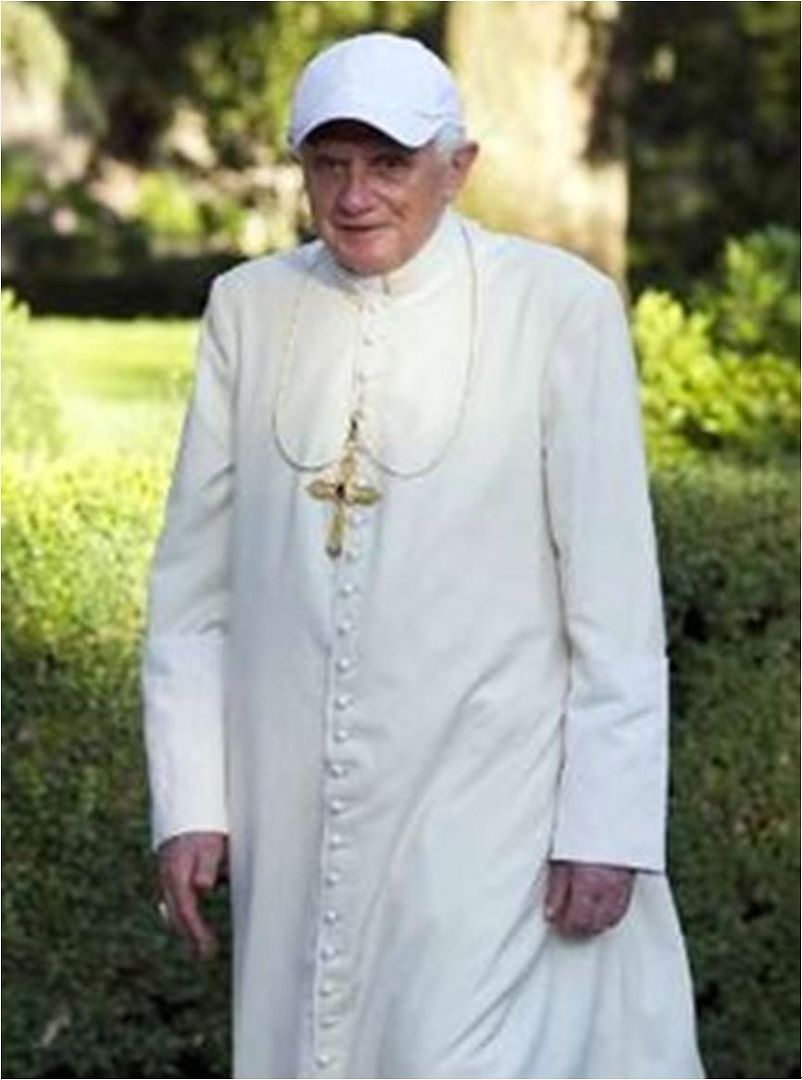
[Modificato da TERESA BENEDETTA 26/07/2010 14:21] |
| |
 26/07/2010 15:09 26/07/2010 15:09 |
|
| | | OFFLINE | | Post: 20.671
Post: 3.309 | Registrato il: 28/08/2005
Registrato il: 20/01/2009 | Administratore | Utente Master | |
|

 So far, the coverage of the papal visit in the Scottish press has appeared to be far less hostile and far less focused on problems connected with the visit. Now, the Herald newspapers even highlight the potential benefits to the local economy of the Pope's visit - a factor that has not been cited in news reports aimed at emphasizing only what the visit will cost.
Papal visit will be
So far, the coverage of the papal visit in the Scottish press has appeared to be far less hostile and far less focused on problems connected with the visit. Now, the Herald newspapers even highlight the potential benefits to the local economy of the Pope's visit - a factor that has not been cited in news reports aimed at emphasizing only what the visit will cost.
Papal visit will be
an £8.5M boost for Glasgow
by Brian Currie, Political Editor

26 Jul 2010
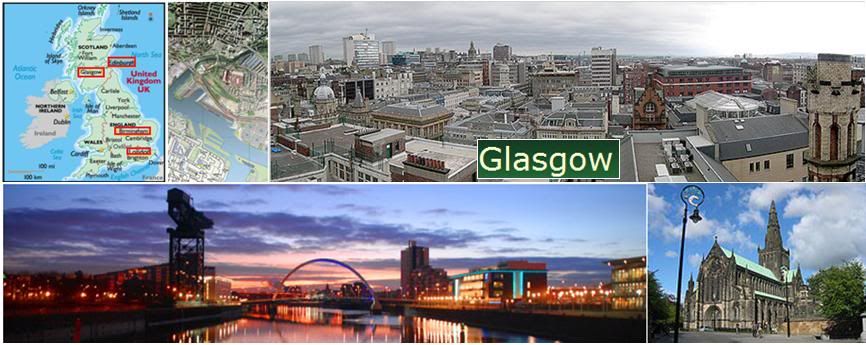 Glasgow is Scotland's largest city, and the third most populous in the UK. 2.3 million people - 41% of the Scottish population - live in Greater Glasgow.
Glasgow is Scotland's largest city, and the third most populous in the UK. 2.3 million people - 41% of the Scottish population - live in Greater Glasgow.
The Pope’s visit to Glasgow in September will boost the city’s economy by £4.25 million and is expected to be worth at least as much again in pubicity because of the global audience watching on television and the web.
Officials have yet to identify the overall costs of Pope Benedict’s fleeting visit to the city for an open-air Mass at Bellahouston Park, but they say expenditure will be outweighed by the benefits to the local economy.
Scott Taylor, chief executive of Glasgow City Marketing Bureau, said the last papal visit in 1982 had generated enormous audiences on television and it is anticipated this year’s event will reach even more because of the internet.
Taylor added: “While the visit will bring £4.25m into the city, the real benefit lies in perhaps a billion people seeing Glasgow on the television and seeing that we are a vibrant and welcoming city.
“Obviously there will be a cost to the city in welcoming someone of the Pope’s stature, and it is too early to say what that cost will be. But you have to weigh that against this once-in-a-lifetime opportunity to show the world what we can do.”
Lord Provost Bob Winter said the visit was a unique opportunity to place Glasgow in front of a huge worldwide audience.
He said: “The Pope is a major global figure, and we should be honoured and pleased that he is coming to the city as part of his state visit to the UK. The Pope’s visit to Glasgow will benefit the city’s economy by more than £4m, a figure that underlines the importance of attracting major events of all kinds.
“I look forward to the city successfully hosting what will be a memorable occasion. I am certain that our visitors from around Scotland and beyond who will attend the Papal Mass will share the positive impression that so many people coming to Glasgow leave with.”
A city council spokesman said there would be costs associated with the visit but it was too early to say what they would be.
He added: “We are confident that the city’s profile will be raised to a global level around September 16 when the visit takes place and that there will be a significant economic benefit.”
Catholic Church spokesman Peter Kearney said: “More than 100,000 pilgrims from the north of England, Ireland and across Scotland are expected in Bellahouston Park and their time in Glasgow will be of great benefit to many businesses and traders in the city.”
“Because of the Pope’s presence, news bulletins around the world will mention the city to its long-term economic advantage. Such global exposure is invaluable.
“Ultimately, the economic value of the Pope’s visit will dramatically outweigh its costs on a scale that no other global visitor could begin to match. It is a significant and welcome boost.”
Glasgow Chamber of Commerce chief executive Stuart Patrick said the occasion would bring many thousands of people to the city from all over Scotland and beyond.
“Major events are at the heart of Glasgow’s tourism strategy, and the visit will have undoubted economic benefits as visitors spend money in our hotels, restaurants and shops,” he said.
The four-day visit from September 16 to September 19 is the first state visit by a Pope to Britain and the costs will be split between the state and the Church.
It will start in Edinburgh where the Pope will meet the Queen at Holyrood Palace before moving on to Glasgow, London and Birmingham.
In the TOXIC WASTE BIN, I am posting a really lowdown attack on the Pope launched in the form of a book by an Italian-born 'Catholic' writer. From the account by a blogger on Catholic Herald, it's all insinuation, obviously, but still a work of malice that is a companion piece to the Panorama article. It could have been much worse, Fortunately, there's a limit to what can be made up with sheer speculation alone.
Fortunately, here's something to freshen the air after that bit of unpleasantness.... From one of the more diligent blogger priests in the UK:
Brighton parish priest launches
'open letter' for Pope Benedict
from the priests of England and Wales
by Fr. RAY BLAKE, Parish Priest
St Mary Magdalen, Brighton, UK

July 26, 2010
In the morning I had a phone call from a priest reader who was very concerned about the direction was taking in this country. I think quite a few of us concerned - the lukewarm approach to the Pope's visit intensifies that concern. He said we should start something like Australian Confraternity of Catholic Clergy. I agree with him we really do need something like it, the problem is: who would organise it?
I think maybe, following Professor Beatie's example an open letter might also help. I am more than a little concerned that the address of the Pope's address at the ad limina [visit] of our bishops seems to have been buried, so what do think of this? If you are a priest and you agree, add you name and address. All the quotes are from the Pope's address.
AN OPEN LETTER TO HIS HOLINESS
POPE BENEDICT XVI
We, priests of England and Wales, wish to express our joy at the forthcoming visit of His Holiness Pope Benedict XVI to Britain.
We welcome the many wise things the Holy Father said to us through our Bishops on their ad limina visit earlier this year which are of particular significance to the health of the Church in England and Wales, such as "the Catholic community in your country needs to speak with a united voice" and the need "to be attentive to the promptings of the Spirit, who guides the whole Church into the truth, gathers her into unity and inspires her with missionary zeal".
More than ever, with the proximity of the Papal visit and anxious for its success we recognise especially the need "to draw on the considerable gifts of the lay faithful in England and Wales".
Concerned for the Church's mission we to see a great need in England and Wales to ensure "that they [not only the lay faithful but we priests] are equipped to hand on the faith to new generations comprehensively, accurately, and with a keen awareness that in so doing they are playing their part in the Church’s mission".
We also acknowledge the importance within our national context of what His Holiness said about the Magisterium, "In a social milieu that encourages the expression of a variety of opinions on every question that arises, it is important to recognize dissent for what it is, and not to mistake it for a mature contribution to a balanced and wide-ranging debate. It is the truth revealed through Scripture and Tradition and articulated by the Church’s Magisterium that sets us free."
We wish to thank His Holiness for encouraging our Bishops to hold up to us "an example of dedication to prayer, pastoral sensitivity towards the needs of his flock, and passion for preaching the Gospel", and also for urging them encourage the faithful "to avoid any temptation to view the clergy as mere functionaries but rather to rejoice in the gift of priestly ministry".
Make a virtual pilgrimage
with the Pope via GoogleEarth

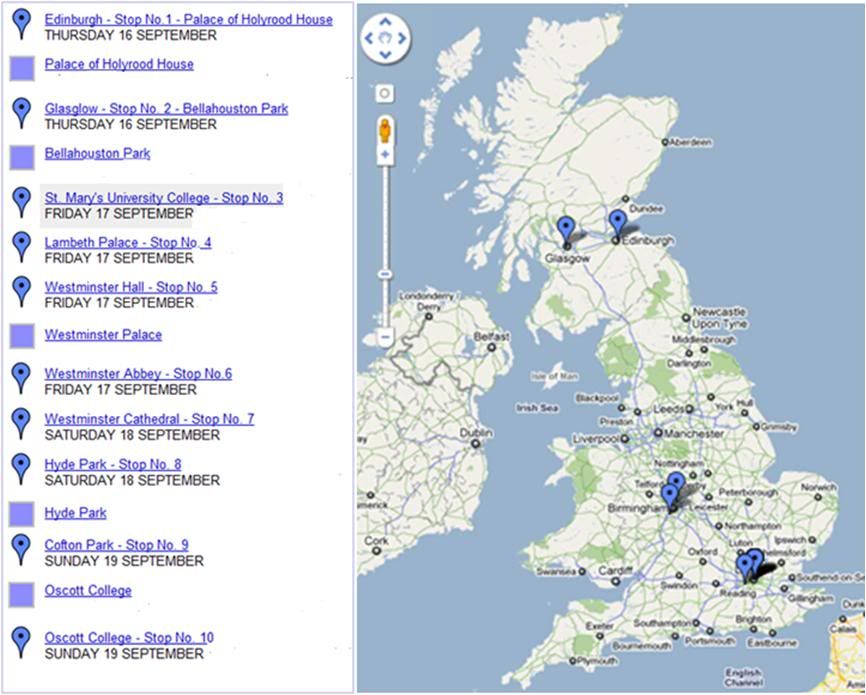 Clicking on each event site on the interactive page will enable further research on each location and event.
Clicking on each event site on the interactive page will enable further research on each location and event.
A reader of Protect the Pope.com has sent in the following link that enables us to pray for the Holy Father at each site of a papal event.
maps.google.com/maps/ms?ie=UTF8&oe=UTF8&msa=0&msid=111051465581092342220.00048b6a31bd6...
Clare Krishan writes, ‘Make a virtual pilgrimage and pray for each of stations on his journey, and learn a lot about regional aspects of the Roman Catholic faith in the UK in the process.’
[Modificato da TERESA BENEDETTA 27/07/2010 01:35] |
| |
 26/07/2010 20:20 26/07/2010 20:20 |
|
| | | OFFLINE | | Post: 20.673
Post: 3.311 | Registrato il: 28/08/2005
Registrato il: 20/01/2009 | Administratore | Utente Master | |
|
 How to respond to 'scandal':
How to respond to 'scandal':
A lesson from Benedict XVI
by Bruno Mastroianni
Translated from

July 23, 2010
Not enough attention has been given to the Pope's decisions regarding the Legionaries of Christ.
Yet it was about a very thorny problem that festered for decades until Benedict XVI took it in hand.
It is also one of the most vivid realities in a Church which was confronted with the worst of situations - a founder who was widely haled as a living saint and who has been shown to be a grievous sinner.
And the Pope has been moving decisively, but also wisely.
It would have been easy - at a time when the controversy was peaking over pedophile priests - to yield to media pressure and do something flashy and immediate.
Benedict kept his own course and counsel, ordered an apostolic visitation in depth, waited for the results of the investigation, and has now named his delegate with full powers to heal the Legion.
[The papal delegate, Mons. Velasio Di Paolis, is both an expert in canon law and in financial affairs, a man of proven faith and a member of a congregation himself.]
Benedict never forgets about the victims - indeed, his primary concern is for them, in this as in the pedophile abuses. "A great part among the Legionaries were in the dark [ about their founder's double life]," the report on the LC said.
In short, the Holy Father showed courage in facing A terrible situation; farsightedness in not yielding to media pressure for a quick fix; the wisdom to heal a crisis in order to build again rather than to punish and destroy, keeping in mind what would be good for all concerned, rather than what it would look like to the media - and all the while giving time and the proper weight to everything.
At a time when the tendency is for patch-up jobs, external maneuvers and other visible operations meant to give the appearance of 'action' in response to crisis, we had almost forgotten those qualities that make for a true leader!
Mastroianni has not posted a new blog entry for the past week - the article above is from the Opinion pages of TEMPI - but checking out his blog today, I realized I had missed seeing the following from July 2:
New archeological discoveries
confirm Benedict XVI's line
Translated from

July 2, 2010
Faith, according to Benedict XVI, is not foolishness, but a recognition of the credible testimony of the Apostles - they were a handful of men, simple and poor, who appeared to have been broken because their Master had been crucified.
And yet, after the first Pentecost, many wise, noble and rich persons converted quickly upon hearing them preach. It is a phenomenon that the Pope, in a recent audience, called "historically miraculous, for which it is hard to give a reasonable explanation, other than the encounter of the Apostles with the Risen Christ".
And that is why despite the waves of scandal over pedophile priests and the more recent one about questionable business dealings at Propaganda Fide, the Pope has been his usual calm self.
Priests and sex, priests and money. Those are the classical arguments that for centuries have unleashed prurient attention towards the Church.
Today, this attention is documented daily in all the forms of modern media, but the substance has not changed - this drive to stir up the turbid waters of human weaknesses (true or presumed) among the ministers of the Church.
But the future of the Church does not depend on them.
Last week in Rome, valuable new archeological discoveries were presented - the oldest known artistic depictions of the faces of Peter, Andrew and, John brought to light in the Catacomb of St. Tecla. It required two years of painstaking work with lasers to divest them of the incrustations that had kept them hidden for centuries.
It is surprising how this archeological recovery coincides with the spiritual program that the Pope has been proposing to the members of the Church: to show themselves with the faces of true apostles of Christ.
And that is what will rid them of the patina of evil that the media have chosen to obscure them with.
[Modificato da TERESA BENEDETTA 27/07/2010 12:18] |
| |
|
|
|
|